Galápagos Day 3 — Pinnacle Rock
If you google Galápagos Islands you will almost certainly see this picture:
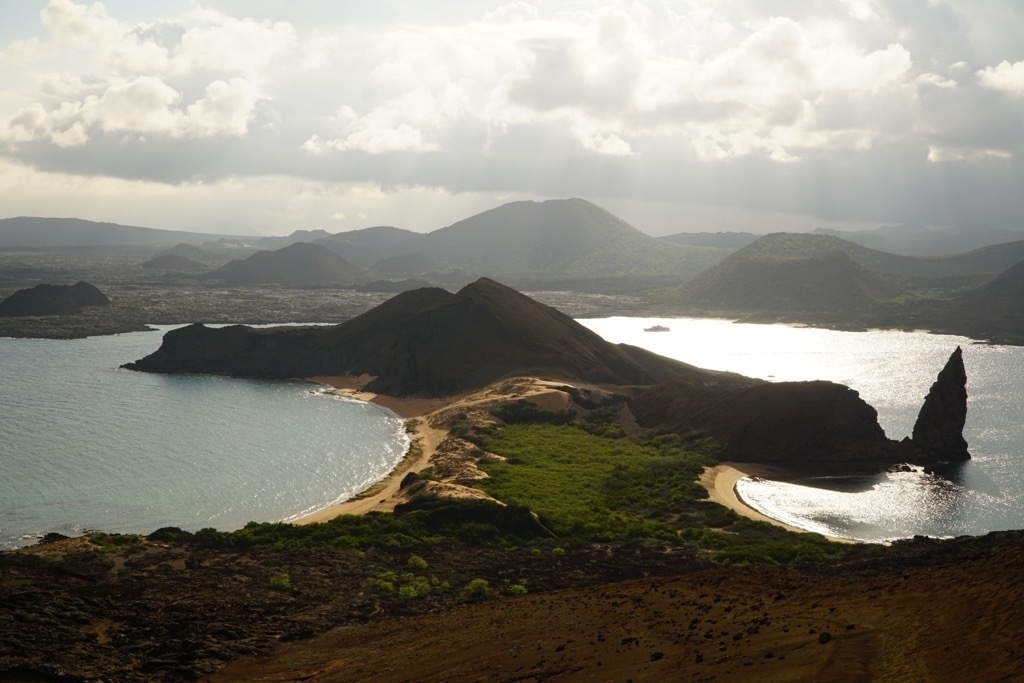
You will likely see even better photos than the one above as we were there at the wrong time of day for optimal photo lighting.
The hike was mostly just climbing the 366 old wooden stairs and many boardwalks to the top of the volcano where there is a great viewing and picture taking spot. Along the way we stopped to learn a bit about volcanology, spatter cones, calderas, and craters.
The naturalists on board are all great and really knowledgeable. Most, if not all, of them were born on the islands and you can tell they all really love it.

Galápagos Day 2
Looking out the window in the morning we couldn’t see anything. Had our luck changed? Were we going to have a rainy day after all? I went up on deck to investigate and was happy to see that it was just a dense fog. Caused by the cold water currents running up against the Galapagos ridge. It would burn off. All credit to Ann who insisted that we take the 10:00 excursion rather than the 8:00 excursion. This is what the fog looked like just before we boarded our zodiac at 10.

We later learned that it was so foggy during the 8:00 trip that one of the zodiacs took a wrong turn in all of the mangrove and got lost for a bit. Apparently everyone was taking it in stride and singing the theme song to Gillian’s island (except for one passenger who was not amused). I almost wish I was on that boat so I could tell the story in more detail. Here you can just barely make out our ship in the fog from a distance.

We were headed into a huge lagoon protected by mangroves but on the way we got some good sitings of a few of the marine birds. Below is the famous Blue Footed Boobie. Yes, I kind of giggle inside like a seventh grader every time I say that. The reality is that the name comes from the fact that they act like clowns during their mating dance. Kicking their legs up and flapping their wings and acting like fools.

We also got very close to a few brown pelicans.
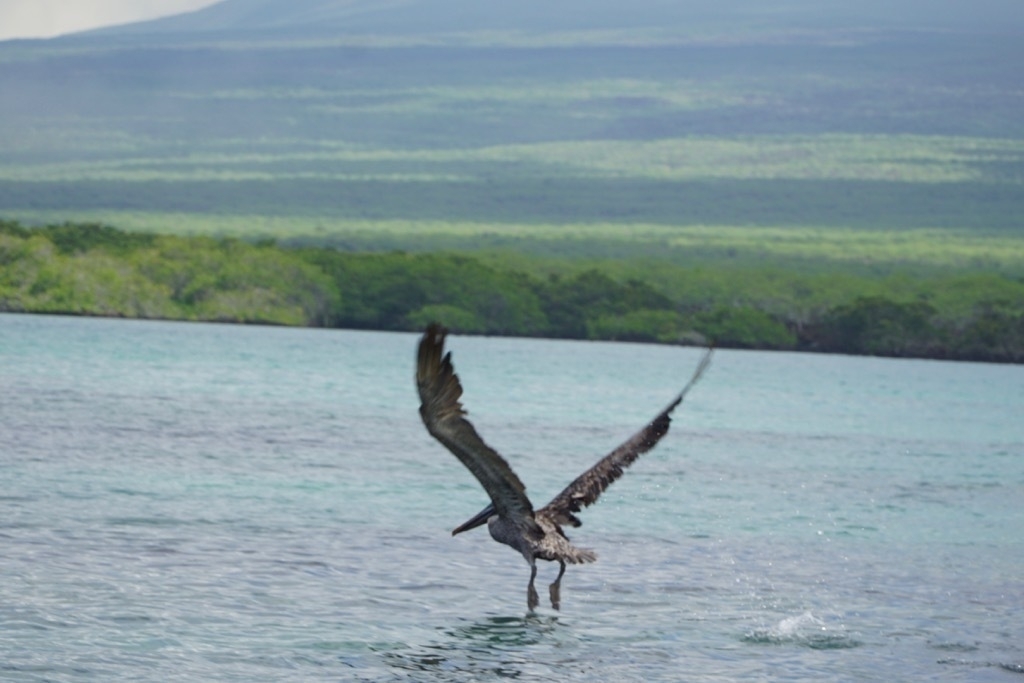
And we saw the Galapagos Penguin! The second smallest penguin in the world.

They look kind of dopey and slow when they are out of the water but when they are in the water they swim fast and graceful.

We saw turtles all over the place poking their heads out of the water, but it was not until the afternoon when we did our deep water snorkel that we really got to have a great view of the turtles.

Toward the end of the trip we were way back amongst the mangroves and we saw a sea lion sleeping on a branch just a few feet above the water. We also had a very close encounter with a Great Blue Heron
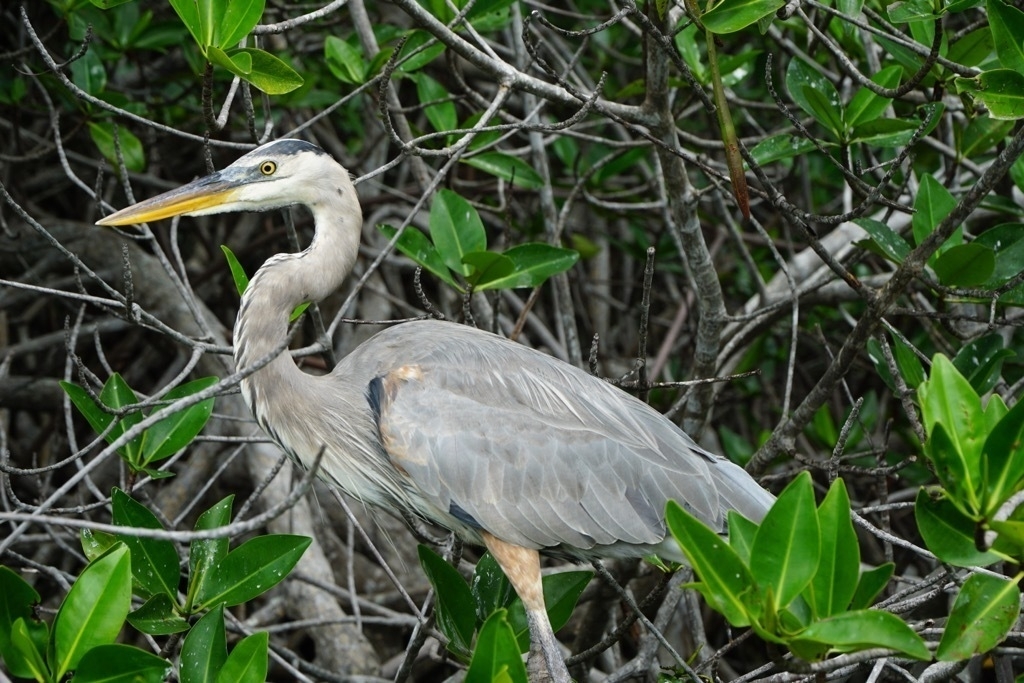
We were also lucky enough to see some golden rays swimming just beneath us. Too bad that we were not able to capture them on camera.
Hike at Tagus Bay
The afternoon was in Tagus bay where we started with a drift snorkel. It was great, we saw a lot of sea turtles, and fish, but the most amazing was when I got to watch one of the penguins swimming underwater.
After we dried off from the snorkel trip we headed out for the “fitness hike” This was billed as a faster paced walk with fewer stops but the same great scenery. With people of all different ages on the cruise the walks tend to go at the pace of the slowest person in the group so we thought this would be a good option. And it was.

We climbed 150 stairs and then walked a bit to have a great view of the bay and this highly salty inland lake.
After a mile we came to the end of the trail where we could see the difference between the two sides of the volcano we were climbing. We were climbing the wet side and were suddenly treated to a huge vista of the dry side. You could images that you had just landed on mars!

We took another short zodiac ride to view the geology of the volcano and some of the wildlife. Here you can see the layers where the older layers have oxidized!

After we got back on the ship we had time to relax with a happy hour drink and enjoy the amazing sunset.

Up next was a delicious dinner where we watched one of our exhausted fellow passengers fall asleep right at her table with conversation and laughter going on all around her.
After dinner there was a small party to celebrate crossing the equator on our way around the north end of Isabella island. We were all encouraged to do the limbo and imitate one of our favorite Galapagos animals. As a group we did the blue footed boobie dance, and narrowly lost the contest to a couple imitating sea lions.
Galápagos Islands!!
Iguanas fighting over territory, thousands of crabs, two species of sea lions, lizards galore, birds and even a snake; this is what we saw on our first day in the Galápagos!
Today was a good practice day as we all learned about “wet landings” and “dry landings” in the Zodiacs we use to transfer from the ship to the shore. We go in groups of up to sixteen people along with a naturalist that will take us on our hike once on shore. It’s a bit of a process this first day to get off the zodiac in the water, then change shoes in the hot sand, but we are getting the hang of it.
We hiked for about 90 minutes and saw a lot of amazing animals…

When we first came ashore, we saw this baby sea lion just hanging out on the rock. Very cute.
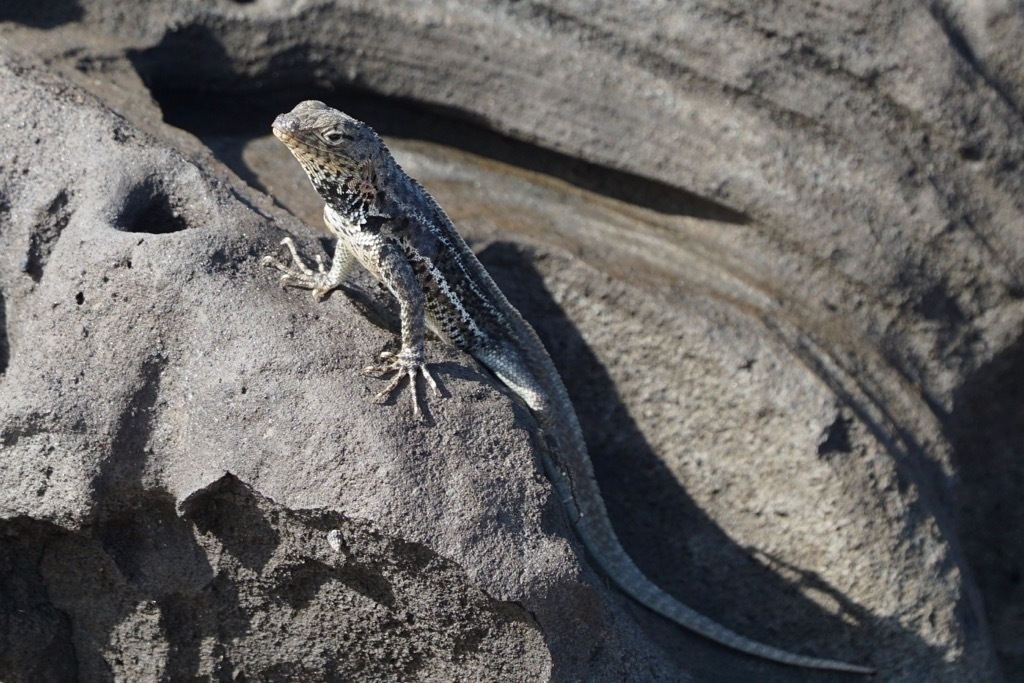
The next thing we noticed was the lizards. They were everywhere and you had to be careful as you were walking so that you didn’t step on them! They are cold blooded so at this time of the morning they were all out on the warm sand bringing up their body temperatures.

Of course the Galapagos are home to many many birds, and they have no fear of humans, very few of the animals on the islands do! But this one takes the cake as it landed on Ann’s hat. The guide told us that they really like cameras with big lenses and that they will use them like a mirror to admire themselves.

After hiking the inland part of the trail we started to walk the shoreline. Our first site was the sealions. They are nocturnal, so they were just floating in the cool waters and resting during the day. Looks like a pretty good life to me.

The shoreline was just full of these red crabs, called “sally light foot crabs”. Here you can also see one of the many iguanas looking at them. The iguanas eat algae so its not hunting them. The Oyster catcher birds, do hunt the crabs, and we saw some of those as well.

And here is the king of the iguanas! Looks like he is in charge to me!
Rabida Island

In the afternoon we headed to Rabida island for some more hiking and snorkeling. Here we are in all of our orange splendor.


The hike was hot but really beautiful.

I just loved how the prickly pear cacti just grow right out of the lava rock on this island.

This is a brackish lake. Much of the water comes from rain and runoff from the hill behind, but at high tide, some water can flow over the mangrove berm and into the lake as well.

And this is the frigate bird. They are amazing in that they steal food from other birds right out of the air! They also love to float and glide alongside and above the ship as we slowly reposition ourselves.
At the Equator
It turns out that Ecuador is a great place to study the equator. It’s not in the middle of a jungle, but runs close to Quito with lots of varying terrain. They thought that they had the equator nailed, but then along came GPS and they found out there were off by about 200 meters. Now at the new and improved site we got to explore some of the common, cool things you hear about our hemispheres.
We did the water test. Yes, when the sink is directly on the equator the water goes straight down the drain. Moving it ten feet to the south the water makes a vortex going clockwise. When you move the sink 10 feet to the north the water drains counterclockwise! This is supposed to demonstrate the Coriolis effect, but I’m skeptical (and so are lots of other folks) that the effect would really be that different just a few feet either side of the equator.
We balanced an egg on the head of a nail. It was a bit windy and tricky to get right, but in the end both Jane and I accomplished the task.
We saw the sundial telling us the “true time”. It was about 20 minutes off from my watch.
And we did a strength test. This seems to be the most controversial and unexplained of all of the equator tests we did. Standing a few feet off the equator you can resist quite well someone pulling down on your arms. But standing directly on the equator line you seem to lose all your strength. Other than psychological explanations for this I haven’t found a physics based reason for why this is true.
In the moment it doesn’t matter whether any of these things are true or not, it was a good and fun way to spend our afternoon.
Cusco Cooking!
After a morning with Chef Jose you will definitely believe that Peru is the center of the culinary universe, and has been for thousands of years. Did you know…

-
All tomatoes in the world originated in Peru?
-
All potatoes in the world originated in Peru?
-
Peru has been the top culinary destination in the world for several years running?
-
There are thousands of varieties of potatoes?
-
There are at least 3 different varieties of passion fruit?
Chef Jose picked us up at our hotel, and walked us the few blocks to his restaurant/culinary school. We started out with a fruit quiz. We actually got the first 4 of nine correct. Jose said we did way better than most.
After the quiz we tasted each of the fruits. Yes, me, I tasted all of them. Truthfully I liked most of them, except the one that looked and had the same texture as an avocado! The quiz didn’t include any banana or plantain as I had already told the chef I couldn’t eat them.

In the meantime, every few minutes someone would come in with a new appetizer for us to taste. Crunchy bruschetta and shrimp with Peruvian cheese melted on top. Delicious.
After the fruit tasting we went into the next room where we were introduced to many different ingredients used in Peruvian cooking. We learned about many different types of Quinoa, which has become so popular around the world that Peruvians have had to look for alternatives because its become so expensive in Peru!
Next up was a bit of mixology. We learned how to make the traditional Pisco Sour and another drink called a Chilcano. It was too sweet for both of us, so we decided to stick with the Pisco Sour. Which we took with us into the kitchen where we started on our first dish of the day. Ceviche — “Made with Love”. We learned not to trust any ceviche that is made and allowed to sit more than a few minutes before serving. Of course this means you need to make certain that your fish is absolutely fresh and perfect before you start.
Our ceviche was served with crunchy corn kernels and small cubes of sweet potato. Peruvian chefs love to play with combinations of flavors and textures and this combination definitely allowed for that! It was great, sweet potatoes are even tolerable if you have enough ceviche sauce on them!

After enjoying our ceviche and a little of our Pisco Sour we moved on to our second dish. A classic in Peru, called Lomo Saltado. It combines the wok cooking that influenced Peruvian chefs years ago with crunchy French fries and the rice that is so prevalent in Peruvian cooking. Like many Asian dishes this one cooks very quickly in a very hot wok once you get everything prepped.

When we finished the dish we took it outside and ate it all under an umbrella along with our Pisco Sour drinks. It was great and definitely something I’ll try to replicate back home.
This was a great culinary experience and I would highly recommend it to anyone visiting Cusco and looking to learn a bit more about Peruvian history and culture through the food!

Saqsay Waman
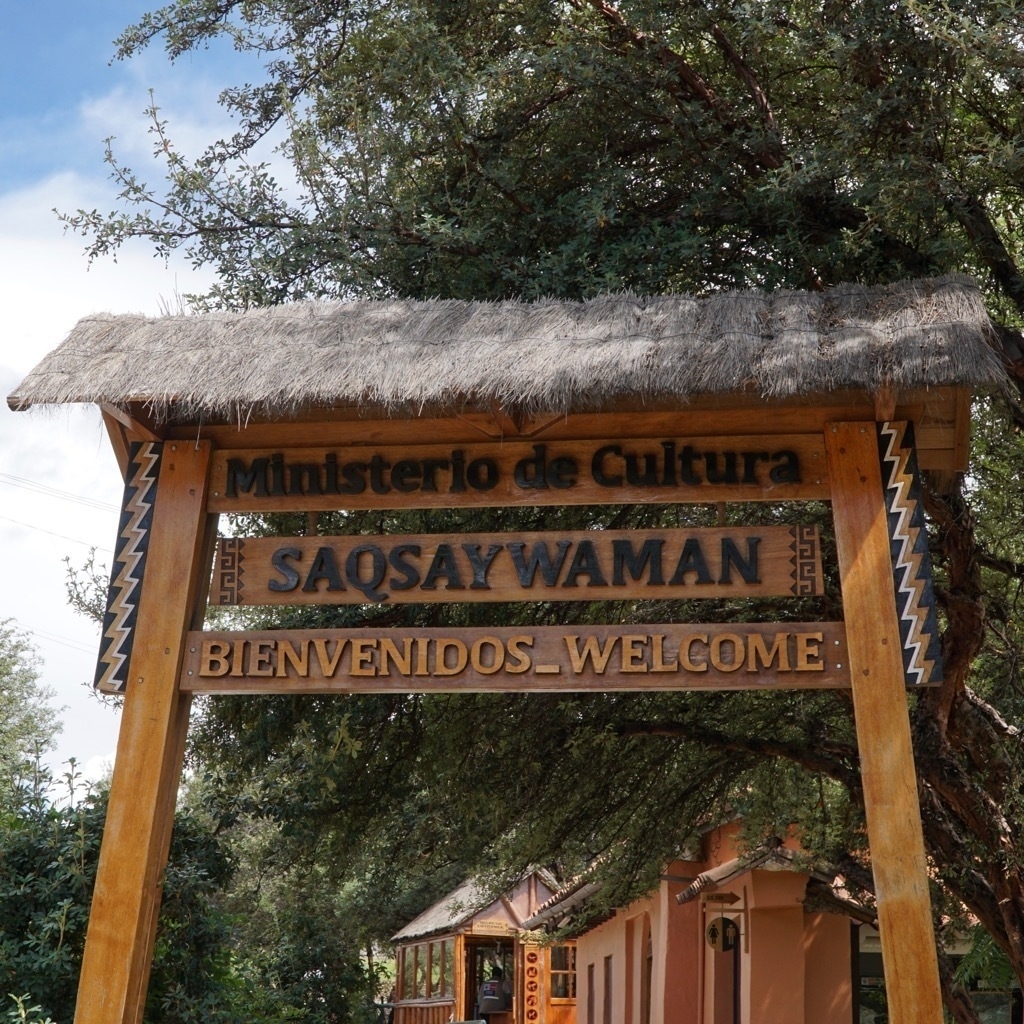
OK, if you say the above title out loud a few times you will know that I had to include that in this post. — Not getting it? Then think Sexy Woman. No, its not a risqué statue in the middle of Cusco it is another huge Incan structure on one of the many hills surrounding Cusco.

The walk around the Saqsay Waman site was also our first chance to get up close to a Llama (pronounced Yama by the locals)
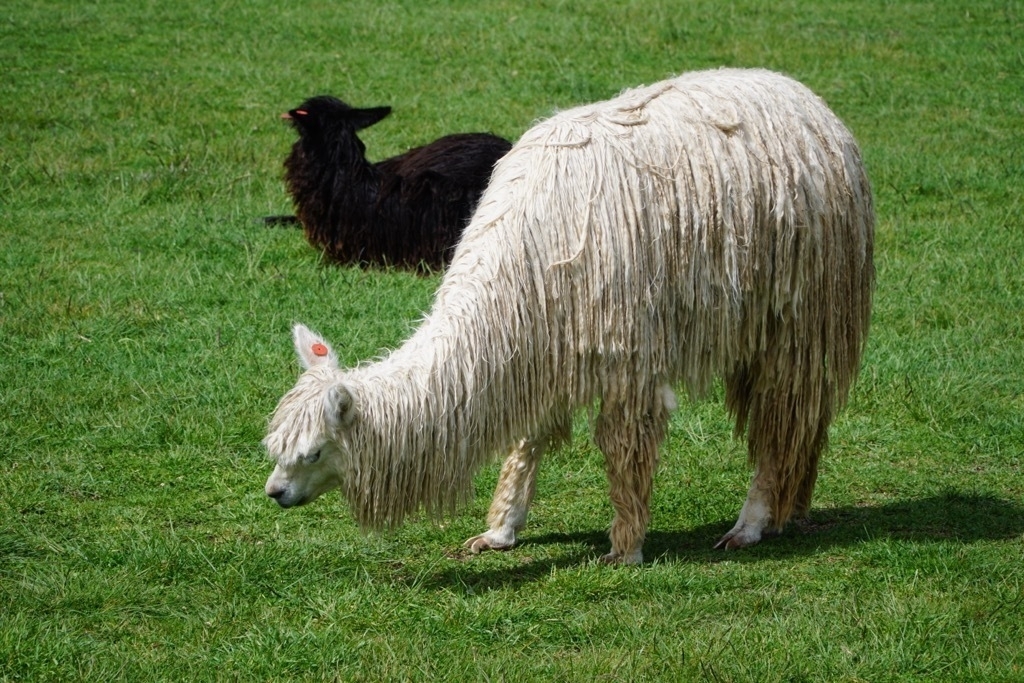
Machu Picchu
It rained hard all night long, and it was still very cloudy when we got up for breakfast. But, by the time Fernando picked us up to go to the bus, the sun was shining and it looked like we were going to have great weather for our visit.
After seeing Machu Picchu from the Sun Gate I wasn’t sure what was left. Plenty, as it turns out. It was just amazing to walk with our guide through this huge complex and marvel at the design and engineering. For everything you see above ground there is also underground engineering work to create the drainage system that has kept Machu Picchu stable all of these years.

One of the biggest threats to Machu Picchu is the number of humans that visit each year. It wasn’t designed to handle that kind of traffic!

Machu Picchu was never finished, due to the Spanish invasion, but nevertheless many people lived there over the five generations it took to get it to what we see. During that time there was even much rebuilding as priests died and new priests took their place and wanted to change or move the various temples.
You can see several different levels of workmanship. From the super high quality at some of the lower layers and in the places where the important people lived to the lesser quality near the top as they rushed to finish, or simply didn’t care to do the same quality of workmanship for the new Spanish conquerors.
After a morning of wandering around, we had a delicious lunch at the restaurant right in the national park. Then headed down to Agua Caliente where it started to pour rain again. We hung out in the market for a while then headed to the hotel, where we met up with Bob and Bonni and sat by the fire until it was time to board our train to take us back to Cusco.
You never know who you will meet on the Inca Trail
I woke up around 3:30AM when I heard a few splatters of rain against the roof of our Casita. The alarm was set to go off at 5AM, groaning internally I rolled over and listened to the rain turn from splatters to a steady stream. Our goal for the day was to do the 7.5 mile Inca Trail hike to the Sun Gate of Machu Picchu. I really was not looking forward to doing that in the rain!
After much tossing and turning 5:00 finally came and we headed up for an early breakfast. We were meeting our guide and driver at 6:00 to head to the train for the trip to our drop off point. At breakfast we met Bob and Bonni who were taking the same train, but going all the way to Agua Caliente and visiting Machu Picchu from there.
When we arrived at the lobby to meet our guide, Bonni was on the phone with their guide. It seems that there was a big accident on the way from Cusco and that their driver was going to be at last 30 minutes late, which would cause them to miss the train. We volunteered to ask our guide to see if they could ride with us rather than riding in the taxi and everything worked out great.
About halfway to the drop off point the rain stopped! By the time we were ready to hit the trail we could actually see a few patches of blue sky peeking through the clouds. This was looking like a good day for hiking after all!
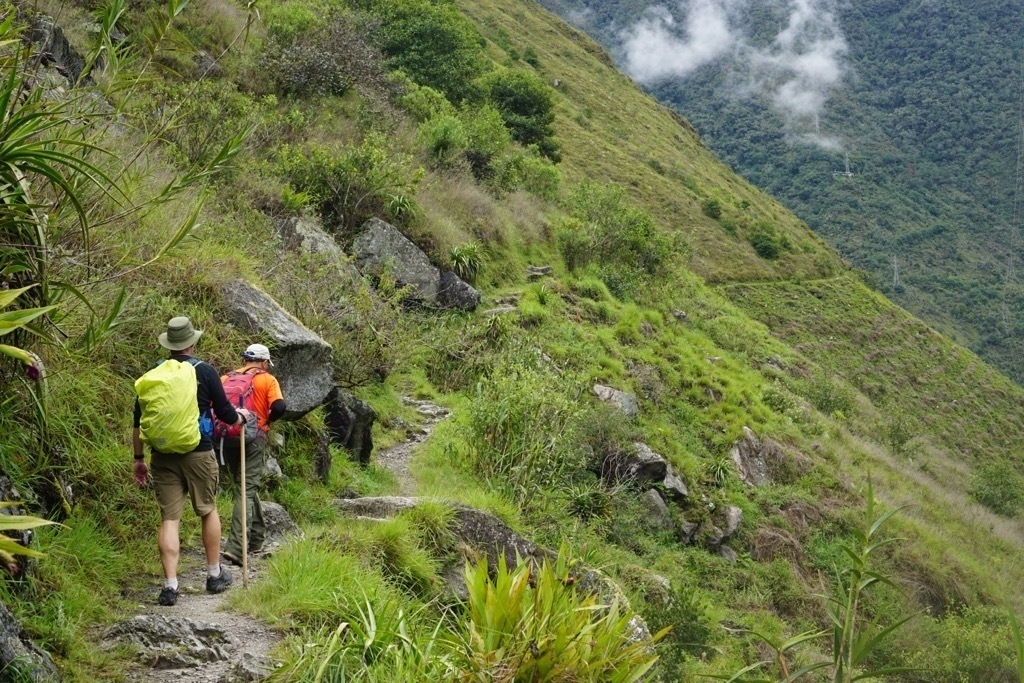
The one day hike has three main parts. The first half is up hill where we gained over 1500 feet of elevation. The next section is billed as being pretty flat, but that’s a lie. It’s flat until the end where you have to climb up to the Sun gate. From the Sun gate its all downhill, but that is maybe the last 1/8 of the 7.5 mile hike.
We took it at a good pace and enjoyed most of the climb. The scenery got better and better as we climbed higher. We were mostly alone on the trail. There was another pair of hikers that started just a bit before we did, and every so often we could catch sight of a larger group of 9 ahead of us on the trail.
Soon we were high enough to look down on the trains as they passed with passengers heading to Agua Caliente.
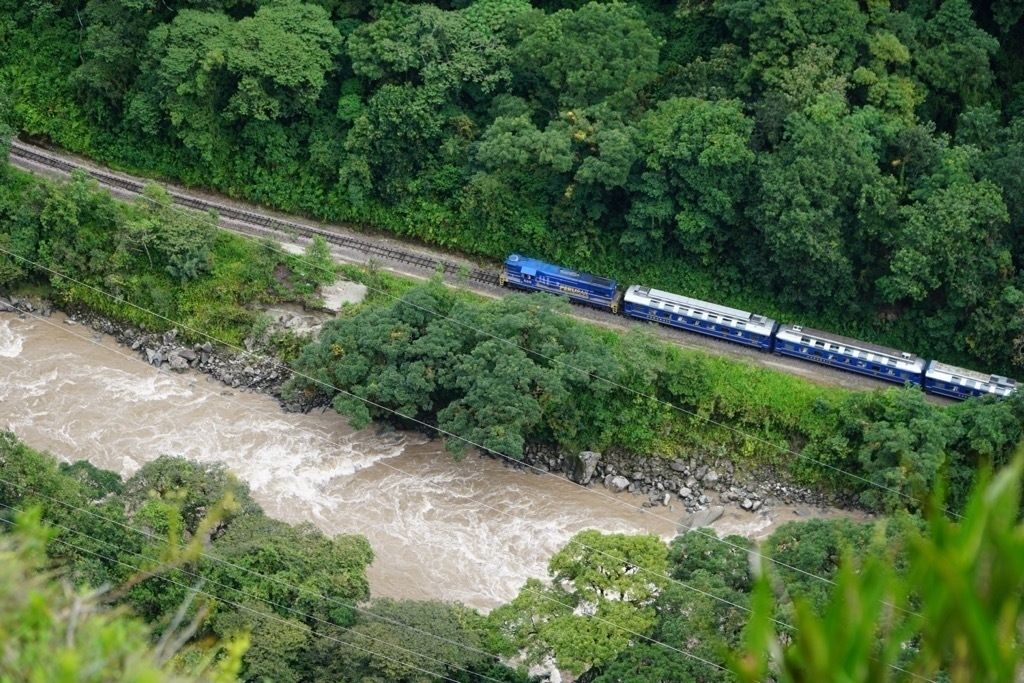
One of the sites we got to see along our hike was the amazing Wiñay Wayra terraces. It was beautiful to see from the distance.

We thought it looked close, but somehow we kept walking and it never seemed to get any closer. Finally we came down a few stairs then up a few stairs and stopped for a rest at the base of a waterfall. This was our time to gather our energy for the climb through Wiñay Wayra. When we arrived the group of nine was just leaving, so we felt like we were doing a good job of keeping the pace.
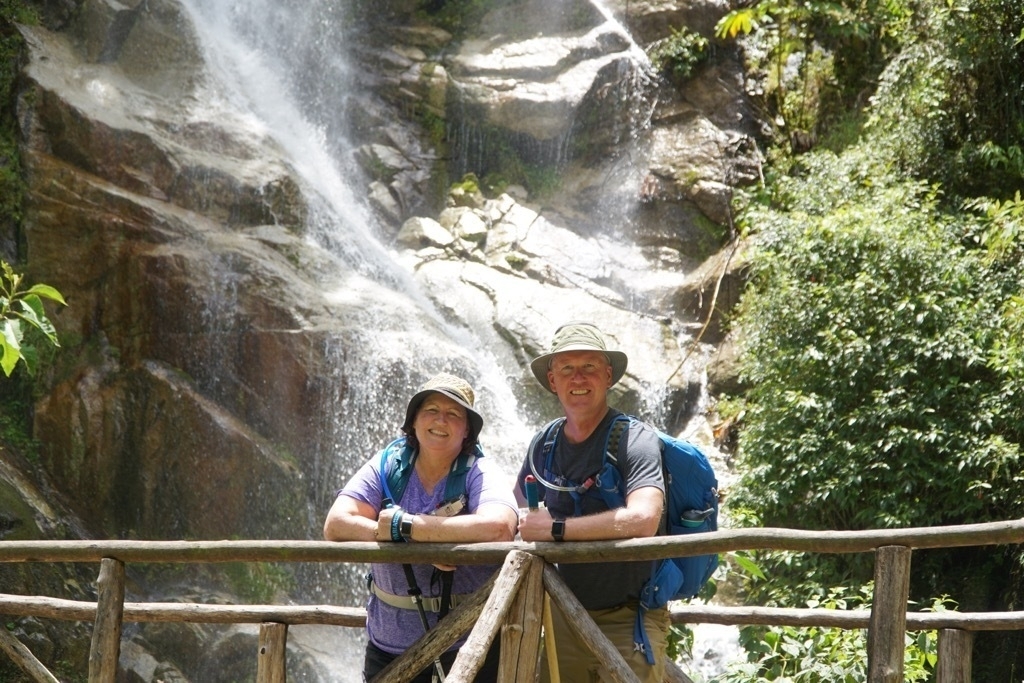
It looks a lot more daunting in person than it does in this photo. And when we finally got to the base I started counting stairs. We were able to do about 60 at a time then we would have to stop and rest and catch our breath.

The altitude definitely makes it harder work! After 375 stairs we finally arrived at the terrace about 2/3 of the way up where we were able to go across and exit. This was an amazing place for a picture.

This was basically the end of the uphill part. Both of us were extremely happy about that. The next couple of hours were pretty easy and we made good time. At some point along the way we even passed the larger group, saying our cheerful hellos as we passed.
The first big surprise of the afternoon came when I came around a corner and in the middle of the bridge ahead of me was a Spectacle Bear! It saw me and quickly headed the other direction, while I fumbled to try to unclip my camera. It moved off the path but Fernando advised us to just be quiet and wait. Soon we saw it again climbing across the limb of the tree.

Our guide had told us about the bear earlier, and we knew that it is one of two bears in the world that are vegetarian. He also said that this was only the second time in 25 years that he had seen one up close like this.
A bit further along we arrived at the first part of the trail where we started to climb toward the Sun Gate. Then we walked some more and came to the second part of the ascent, and then we arrived at the really hard part. You can get a good idea of how steep this was and a view of my best side.

We thought we would be there but we still had 10 more minutes of walking and another bunch of stairs yet! But when we finally got to the end it was so worth it! And we had the view all to ourselves.
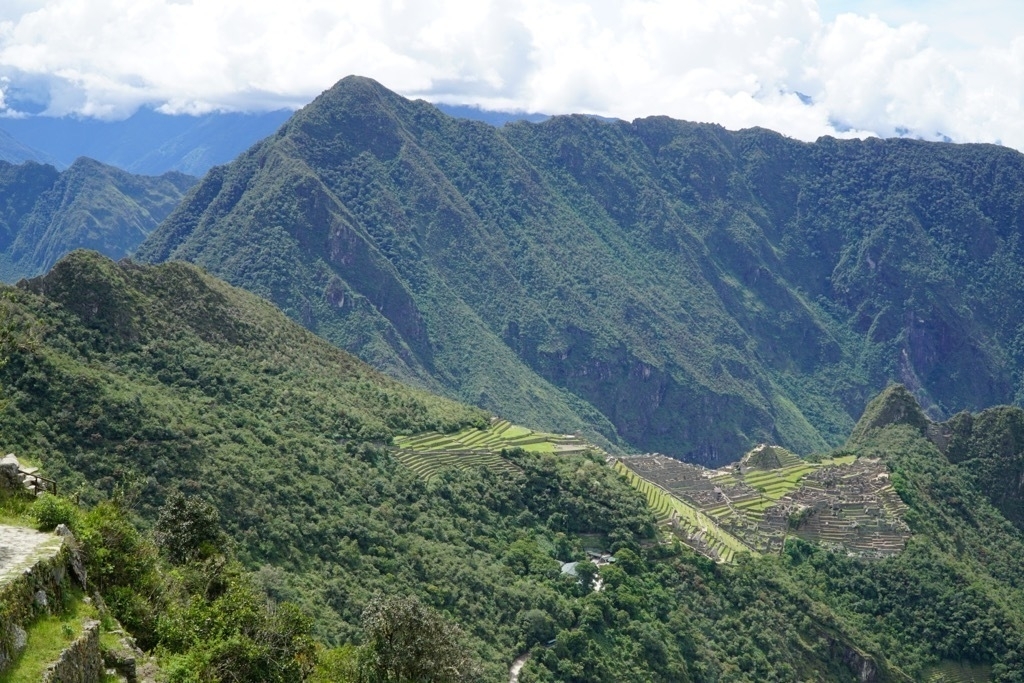
After taking in the view, we moved off to the side where we could site on a nice ledge and have a snack and continue to enjoy the view. At this point the group of nine, that we had passed at some point during the day, came through the Sun Gate as well. We exchanged greetings and discovered that the group was from Minnesota and Iowa. This led to what part of Minnesota, what part of Iowa questions etc. When I said that we had recently moved to Minneapolis from Decorah, I heard a voice say “Brad!?” And this was the second big surprise of the day. Sure enough two of the People in this group were Kurt and Paula Meyer, fellow Luther alumnus and Paula had also been chair of the board of Regents when I served as faculty representative! Amazing!! Four Luther alums on the Inca Trail arriving at the Sun Gate within minutes of each other. What are the chances? Sounds like a data science question.
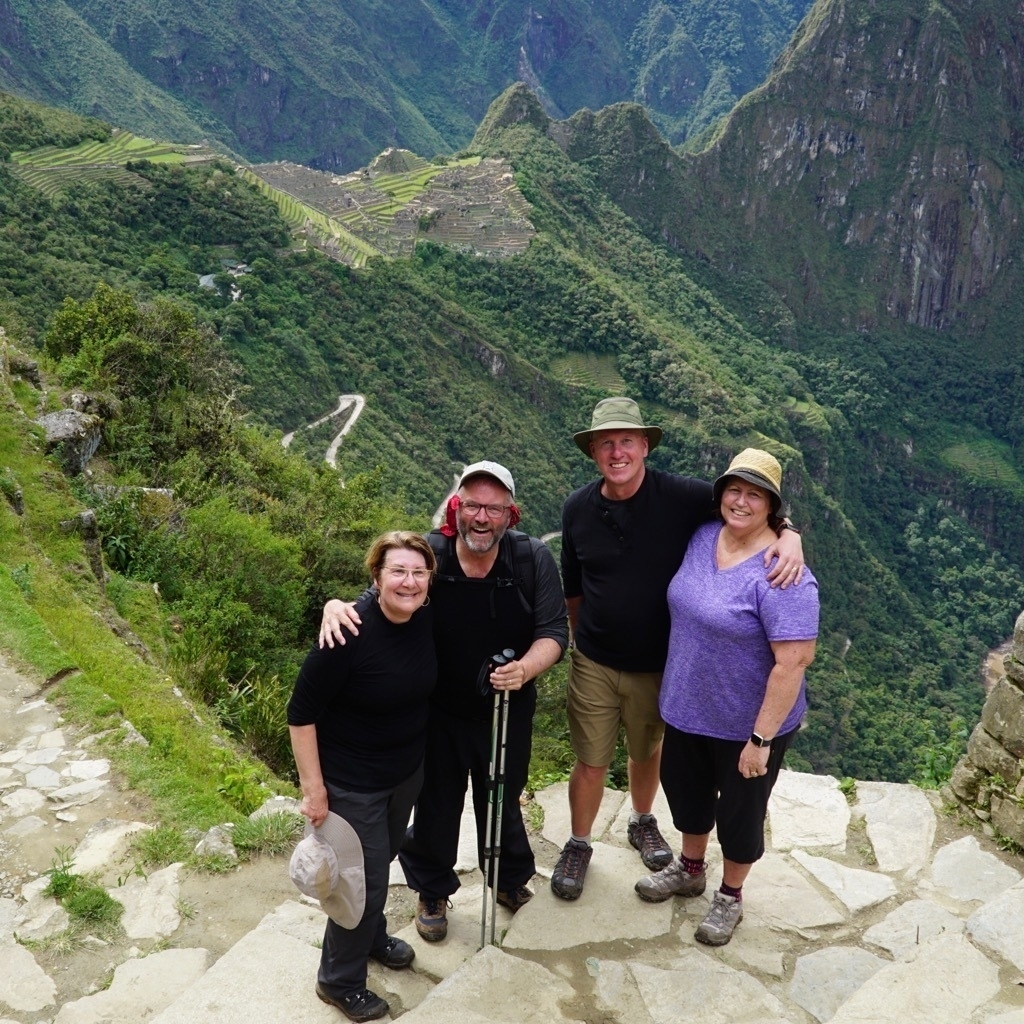
We discovered that we were staying at the same hotel that night, so we said our temporary good byes and we all headed down the final part of the trail. Along the way down we had our third big surprise. Jane was using her hiking poles and poked a viper. Our guide advised us to hurry on by and not pause to take any pictures of the poison snake. So we did.
When we arrived at the bottom we still had to take a bus further down the mountain to Agua Caliente and then a short walk to our hotel, the Inkaterra. At checkin we had the option of the 6:00 or the 8:00 seating for dinner. We thought that maybe a dip in the hot springs (Agua Caliente) would be a good way to relax and rest up for the 8:00 dinner. But by the time we had our complimentary Pisco Sour and chatted about our day with bob and Bonni, we decided that we didn’t have the energy to make it until 8:00. So we switched to the 6:00 seating and we are so glad we did. We were so tired and sore from our day of hiking that we were laying in bed reading by 8:00!
Tomorrow we go back to Machu Picchu to get an up close look!
Into the Sacred Valley
The flight from Puerto Moldenado was blissfully short. It was almost comical how many first time fliers seemed to be on our plane. When we left the runway there were gasps of joy and cheers all over the plane. There were also a lot of children making a lot of noise. Jeez I sound like some cranky old man! But we had barely leveled off before we were getting ready to land again. It was a 40 minute flight but according to Maps a 9 hour drive!
We were met by our friendly guide Fernando who will be with us for our time around Cusco. He had water waiting for us — Hydration is important at altitude as well as a nice hot cup of Coca tea. Also good for helping you get acclimated. Today we were just going to see a bit of the Sacred Valley, a local market and have a bite to eat before checking in to our hotel — Luna y Sol.
The picture below shows the spectacular view of one of the many valleys we saw. The whole base of the valley is filled with CORN FIELDS. They have a huge variety of corn, purple, yellow, red, white and other colors, and the kernels are the size of marbles. It a very important part of the local environment, and they even brew beer with it called Chicha. We have yet to try Chicha, I think it is mostly for the locals.

We did a little shopping at the local market where Jane bought a hand made silver necklace, and we enjoyed a delicious meal… It seems there is no avoiding chicken and rice in Peru. Thankfully they cook it in many different ways! We checked in to the hotel and were immediately captivated by the Jacuzzi!
Our schedule for the next day was for our guide to pick us up at the very reasonable hour of 8AM! This day we had three amazing stops. First was a textile demonstration at a women’s cooperative in Chinchero. It was fascinating to see the hand weaving and how much work goes into making blankets, and belts, and sweaters, and yes ponchos. it may not have been the smartest purchase I ever made, but if you see me wearing it around the cabin or the city you will know that I am wearing a hand made, waterproof, Alpaca poncho. Don’t worry, I didn’t buy the hat!

Our next stop was the terraces of Moray. I was not prepared for this at all!

Were they made by Aliens? What were these for? Who made them? According to our guide these were constructed by the Inca people between 1000 and 1400. Research indicates that these terraces were actually agricultural laboratories! By studying the DNA in the soil they have found that they were learning how to grow many different varieties of potatoes at different altitudes!
It blows me away sometimes to think about the knowledge that we have lost over time. When the Spanish conquered the Inca king and subdued the people and stopped their work, think of the progress and the knowledge that was lost. I’ve had this same thought in many parts of the world such as Pompeii. It makes me appreciate Google’s mission to organize the worlds information and make it universally accessible and useful. It also makes me wonder what could cause the loss of all of the information stored in the Google database? What could cause a similar collapse of a technological empire such as the world we live in today?
We learned that Inca is not really the proper term for the people, the Incas were the rulers the people were Quechua. Our guide explained that it would be like calling all of the Egyptians Pharos. I’m sure we will learn a lot more of their history when we visit Machu Picchu.
From the terraces we continued on to the Maras salt pans. Here we saw 5000 small salt pans where people make salt that comes from a salty spring. Deep in the Andes there is a giant salt deposit that this water works its way through, it then flows down this valley and through the many pans that people have created over the years to make salt. Nowadays they actually make more money from tourism than salt, but I can’t help but think that is a short term setback until some marketer comes along and makes Peruvian Pink salt the next hot commodity for home gourmets.

By the time we finished with all of this it was time for a late Peruvian lunch (2pm) which we enjoyed in the company of our guide and driver all the while just looking at the mountains that surrounded us on all sides. It really is beautiful here in the Sacred Valley!



Amazon Observations
When is a vacation not a vacation? When you are on your third day in a row getting up between 4 and 5 AM. It turns out that the animals are on a little different schedule than we humans.
Our first morning at Tambopata we had to be in the boat at 4:30 to head to the island where we were going to observe the Colorado Clay lick. We were literally up before the birds in order to watch the birds have their breakfast. It turns out that the best theory for why the birds in this area lick the clay is that it is like a vitamin supplement, providing additional sodium and other minerals in their environment that they do not get from the other stuff that they eat.
We set up our viewing point across a narrow branch of the river from the clay and settled in on our stools before the sun came up. We had a bit of coffee to keep comfortable (and awake) as we listened to mostly the silence and waited. Soon the sun started to rise and we spotted a pair of Capibaras swimming in the channel, soon the the silence was broken by a few bird calls which continued to build and build until it was a raucous cacophony of Parrot and Macaw sounds! We saw thousands of Parrots and small green Macaws, we also saw many of the large reds and the blue and greens.
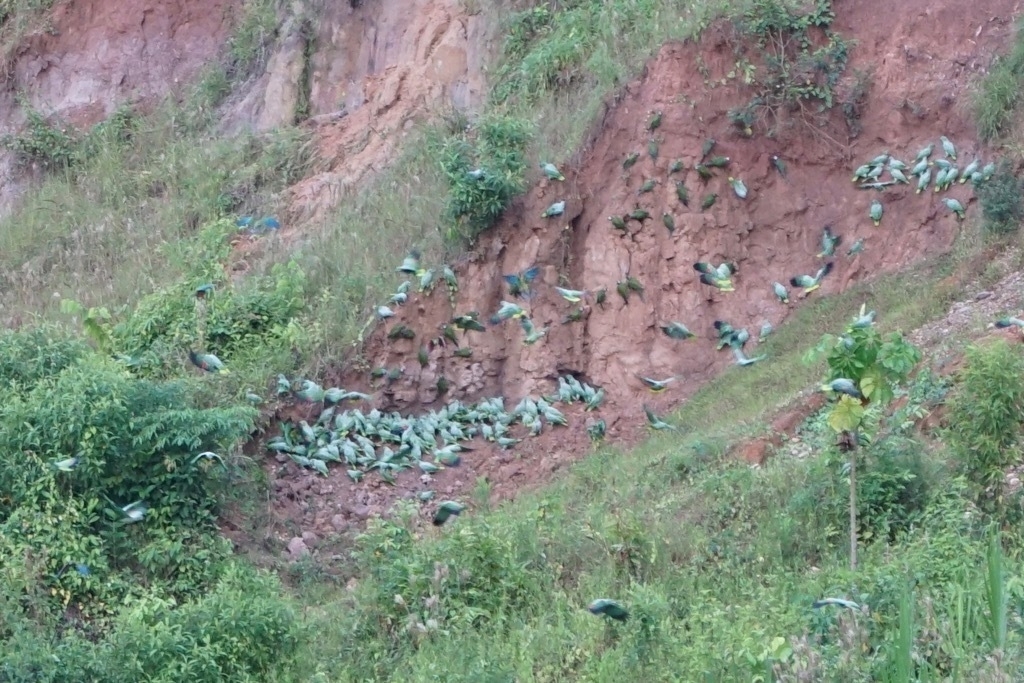
We returned from the clay lick in time for breakfast and a short break before our morning hike to the river overlook. Before we left we were lucky enough to get to watch the Macaw researchers climb the tree containing two Macaw chicks. These are part of their preservation research and so every couple of days they take the chicks out of the nest, weigh and measure them to make sure they are thriving. Macaws are not worried about the humans touching their chicks! In fact part of their research has shown that they will willingly adopt the chicks of other Macaws that are unable to care for their babies. Occasionally the Macaws will have 3 or even 4 eggs, however they are only able to forage for enough food for two chicks. So the last to be born are ignored. These researchers obtained permission to transplant these third or fourth children to nests where there is only one or even zero babies. The researcher told us about a nest that was struck by lightning and both babies were killed. After a time they moved two chicks into the care of the bereaved parents and after some initial confusion on their part the parents started to care for the new chicks.

This next image is of the parents of the baby keeping a careful watch on the researcher who climbed up to the nest.

You never know what you are going to see on one of the jungle hikes, Today we saw a lot of butterflies and Macaws and spiders, some particularly rare bird that our guide was super excited about but didn’t seem that interesting to me. It was also super hot and really humid! It was all really interesting and once we got to the river we were treated to some great views.

We decided that we were going to rest during the shorter afternoon hike and conserve our energy for the night hike.
The jungle walk in the dark was very cool. We stopped at one spot that we had walked by many times on the way to and from the river to observe a tarantula nest! Yikes! I can’t believe we walked by there all those times. I think there are millions of things in the jungle that we walk by all the time without noticing.
We also saw some pretty cool insects and even a scorpion hiding in the bark of a tree.

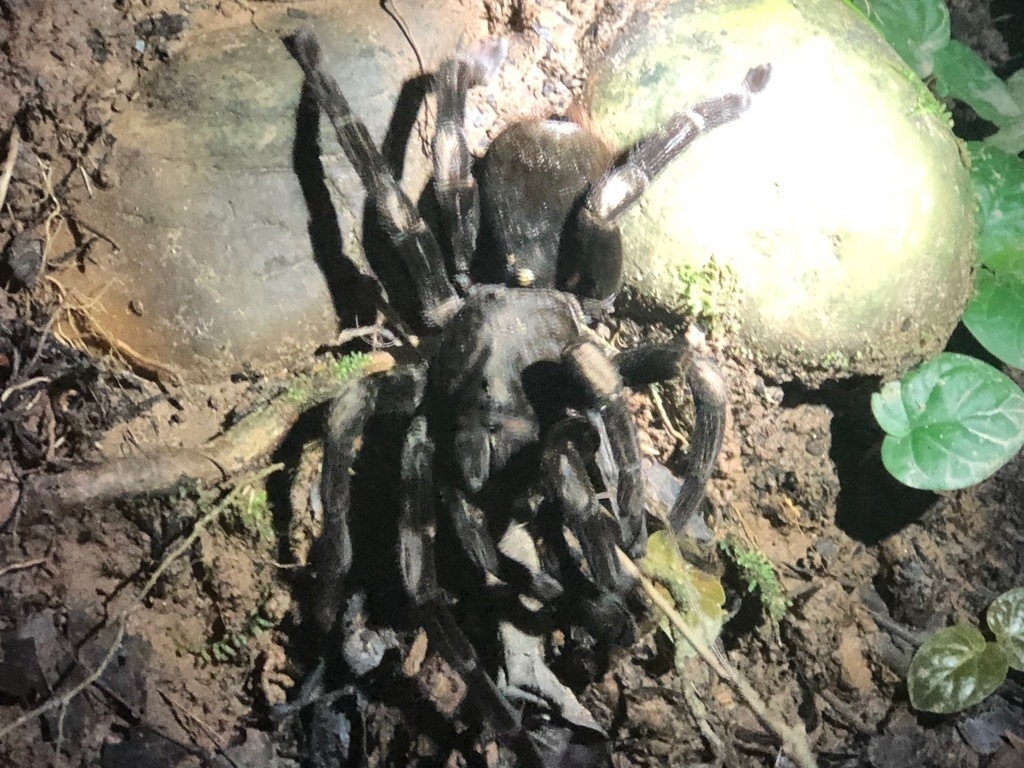
After the night hike we had to get our bags packed and outside our door so the porters could have them loaded onto the boat for our 5:15 AM departure back to civilization the next morning.
The trip back down the river went much faster than the trip up the river — we were going with the current after all. We saw a beautiful sunrise and had a very relaxing ride.

We are really glad that we made the effort to visit and appreciate this amazing part of our planet.
Fun Fact
One of these trees served as the model for the trees in the movie Avatar, the other is inspired by the trees in Avatar. I’m sure you can guess which is which? We were lucky to see both of them in the span of two months.


Into the Amazon
We walked to the light rail station which took us to MSP, from there we flew to Atlanta and onward to Lima Peru. We spent a very short night in the airport hotel, just across the street from the airport. `After five hours of sleep we had a quick breakfast and headed back across the street where we flew to Cusco and then onward to Puerto Maldonado. We were met outside the gate by our guide where we took a short transfer to the boat and a few hours later we were in the rain forrest.
It rained for most of our boat ride to the lodge, but by the time we arrived it was clearing. This meant that we could do the hike to the observation tower. A 120 foot high tower that lets you observe all the different layers of the jungle canopy, including from high above where you can see for miles!
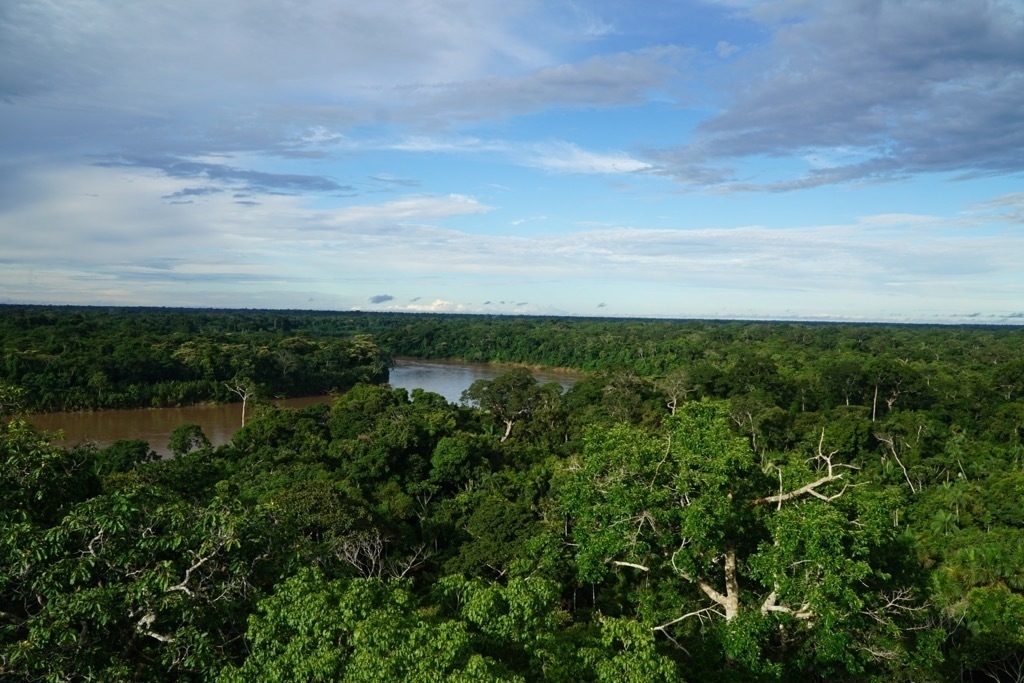
While we were enjoying our view we were joined by a clan of howler monkeys! It was amazing to watch them from above, climb through the trees and then finally up one of the support cables to the observation tower. We were a little worried they might start coming up the stairs but they kept right on moving and climbed down the wire on the other side.

We at dinner as a group, along with our guide at 7:30 and by 8:45 we were in bed. We were tired from the travel and we had a 4AM wake up for the next morning to head out to the lake and then onward for another 5 hours up the river to the Tambopata Research Center.
If you have never heard howler monkeys its really quite a thing! About 5AM we heard a sound that was just like an approaching windstorm. That is the sound that howler monkeys make in the morning to mark their territory. Incredible.
After a short boat ride we had about a 30 minute hike to the ox bow lake where we would go in search of the Anaconda (Still looking), the Caiman (a Peruvian alligator - also still looking), many birds, and do some fishing.
Well, you may be wondering what do you fish for in the Amazon? Piraña of course!

It looks a lot like a Sunfish at first glance. At least until you get a close up look at the teeth! Also, you do not typically use raw beef when fishing for Sunnies!
After our fishing excursion we were back on the river headed to our final destination for the day, which is the Tambopata Research Center. This is one of the only places in the national reserve that you can stay overnight and learn about the jungle. It is really an amazing experience.
Along the way we were keeping our eyes peeled for interesting wildlife sightings. We were richly rewarded when one of the crew spotted a Jaguar. Right out in the open sunning itself! It’s by far the best “big cat” siting we have ever had in all our travels, and I was thrilled to get some good shots.


As a final treat for the day we saw a bunch of Macaws at the “clay lick”. More on clay licking tomorrow after we learn more!

Ladder Canyon
Turn left at the arrow. Hmmm? Would you turn left and head into the rocks here? Despite the giant arrow made of rocks right in the middle of the path it is really easy to miss.

Even when you realize this is the start its a little hard to believe that this is a real trail. But it doesn’t take long before you find the first ladder and then you know you are on your way.
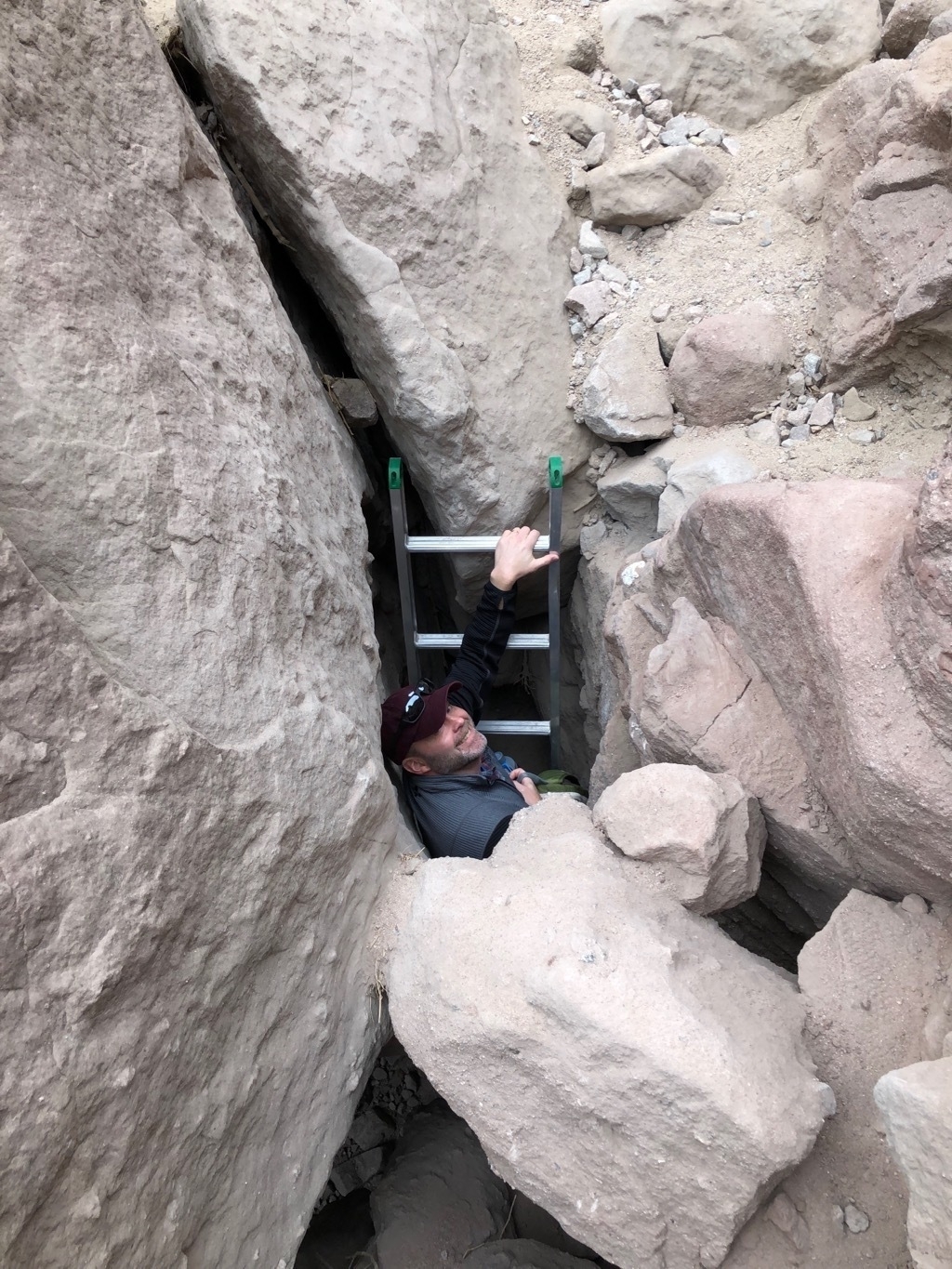
Then you get into the narrow slot canyons and you can really enjoy the hike. Even though this is not a well marked hike so you might feel a little like you are heading into the unknown.

The going is a bit slow but when you arrive at the top you are rewarded with a great view.

The way down is much wider and more open through the beautiful painted canyon. This was a great way to spend part of our last day of 2018.

I like this hiking tradition ever since we saw the #optoutside from REI a few years ago on Thanksgiving. Tomorrow we’ll continue the tradition at Joshua Tree.
Post Bike Tour Quiz
Post Bike Tour Quiz
What country would you be in if I told you the following facts?
- 90% of the people are home owners, 10% are renters and 0% are homeless
- There is no unemployment
- Possession of a firearm is a capital offense
- Possession of drugs is a capital offense
- Universal helthcare
- You cannot buy alchohol (except in a bar) between the hours of 10pm and 7am
- If you have a job lined up your are welcome
- If you are a refugee you are out of luck
- you will pay around 20% of your salary for social security and your employer will contribute another 17% but you don’t pay any income tax.
- If you want to buy an Audi plan on spending around a half million dollars
- You will not see any trash in the streets
- You can leave your bike unlocked or your purse on the table and nobody will steal it.
- Home to the world’s second busiest port
If you thought I was describing some “commie socialist dictatorship” you would be wrong. If you said Singapore, you are correct. I will admit that all of these facts come from our most excellent bike tour guide from Urban Adventures, so some of it could be “fake news” or just a simple embellishment by someone who is very proud of their country. I haven’t fact checked any of it yet. But for as much as we saw some pretty cool parts of Singapore today we heard a lot that really made us think.

Maybe the banner picture gave it away before you even read the question? The Marina Bay Sands hotel is the largest in Singapore and has some very distinctive architecture. A ship on top of the three towers, the hotel is owned by the Sands hotel in Las Vegas. It’s a massive hotel with a casino and mall and botanical gardens and a very distinctive architectural landmark of Singapore. Honestly, the Asian and Middle-Eastern architecure we have seen on this trip make America seem really boring. Hey, lets “make American architecture great again!”
One of the reasons there is no homelessness is that the government provides social housing. For as little as $30 / month for those who qualify you can rent a small 600 square foot apartment. To qualify for the next level of social housing, you have to be married and at least 21 years old in order to qualify for social housing if your job is paying less than $90,000 / year. that may seem like a lot, but it is the average income for Singapore. Once you are in at this level you can stay in for life if you want. Or you can even make improvements and sell your place for a profit later when you want to move into even more expensive private housing.
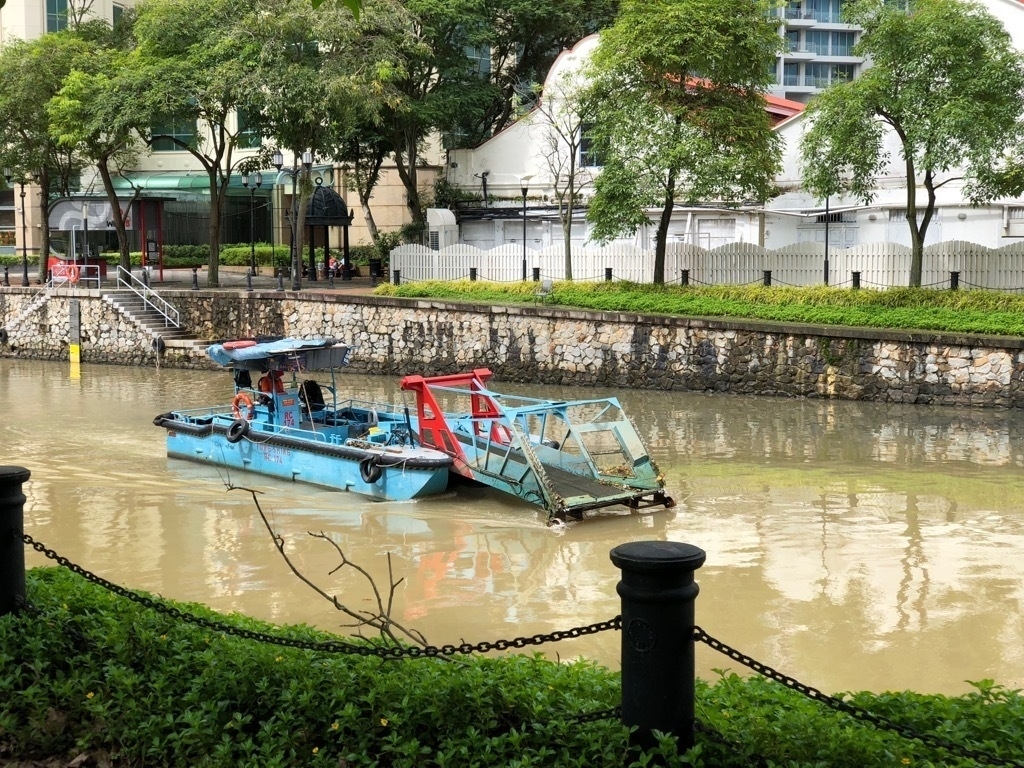
The government is run like a large multi-national corporation. The president makes 4 million a year and if you are elected you can expect to make about a million per year. Our guide put it this way, if you pay peanuts you will only get monkeys. Enough said.

Of course this is all true of a country that has a total population of around 5 million people and is only 278 square miles in size -- That is a bit smaller than New York City. It is home to the world’s second busiest port and the world’s number one airport. The government is run like a business to make money and last year they were 9 billion in the black. I think its easy for an American to look at this wistfully and say what can we learn? Why can’t we be more like this? But I think that is a pretty complicated question that brings into focus our freedoms and our history. I’d be happy to outlaw guns, but I’m not sure sure we should turn away refugees and others in search of a better life. I definitely wouldn’t want to pay half a million for my Audi! But I would support more use of mass transit and more biking in our cities.


Bond, James Bond... Island
Bond, James Bond... Island
Wrong side of the island, wrong end of the beach! That would be the headline for the way our trip started this morning. We got off the ship with a group of 13 that had banded together through Cruise Critic to head off on a swimming, snorkeling and boating trip together. However, it was a bit chaotic at the start. While we could have anchored on the side of the island by the marinas we instead anchored on the other side of the island. And while our guide knew the beach we were supposed to tender into he was informed that we would be tendering to the other end of the beach. So when we got off and started looking for the sign that read “Jane Miller Group” we were suprised to not see one. One taxi driver that had wanted to sell us a tour ended up being particularly nice when he offered to let us use his phone to contact the tour company. They were at the wrong end of the beach which was a long long walk, so they said we should walk to the “family mart” and wait.
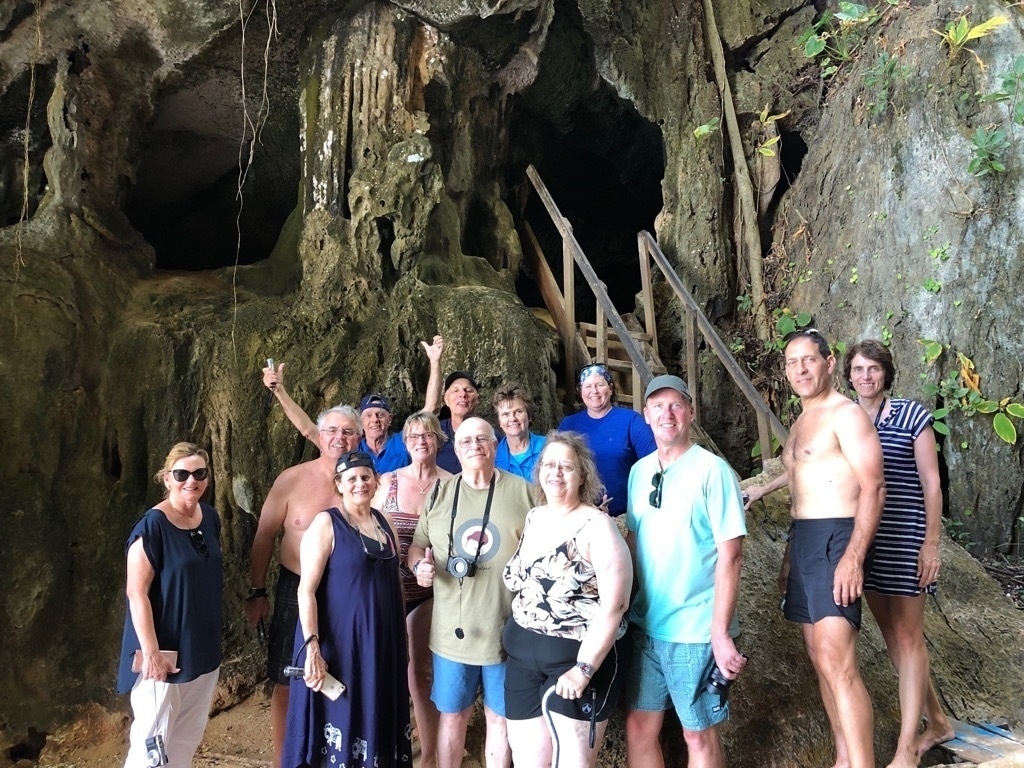
before we even got to the family mart one of our new friends said “Jane, here’s your van”. Sure enough there was a driver with a “Jane Miller” sign. Unfortunately he didn’t have enough room for all of us in the van. So Jane said I should go with the main group and she would wait for a car and ride with our new friends Mike and Karen. Mike is an old army vet who now works as a defense contracter in South Korea teaching war gaming, and Karen is from Austin MN. Although there is a bit of an age gap, we have a lot in common and they were fun to talk to and always up for an adventure.
It was forty five minutes later when we finally arrived at the marina and I had just pulled out my phone and turned on the international plan so I could text jane and find out where she was!? Before I could press the send button however I noticed that she and Mike and Karen were all waiting for us on the sidewalk! OK, mission accomplished, we are all at the marina we can get this show underway. After a short trip to the nearby souvenier store where we paid double the usual cost for our Thai beers and we were ready to board our pink carriage to the boat halfway down the pier.
In our pre-trip briefing, both the owner and our guide for the day assured us that we were going to be back to the dock in plenty of time because they didn’t want anyone to stress about making it back on time for the last tender back to the ship. Great! This sounds good. There is nothing I hate more than wondering if we are going to make it back before the ship leaves.

A half hour later we were at our first stop and in the 85 degree water. Very nice and warm for swimming especially after all of our rushing around this morning and then sitting close together (with life jackets on!! to appease the local authorities) for the first part of the journey. Life jackets were now stowed away for the rest of the trip!

Following the swimming we motored to a group of islands called Phang-Nga bay. These islands were beautiful and reminded us of our time in Halong Bay, Vietnam. We stopped at Ice Cream cave and went spelunking! It was really pretty and brought us through the island where we could see the other side.

We pulled up to a small beach at a national park for lunch. We had a fabulous Thai lunch. By the time we finished lunch it was after 2pm and our guide said we would see James Bond island, the floating village and then do some kayaking before making our way back to the marina at high speed but still an hour away. A few of us began to wonder out loud about the 4:00 return time. It turned out that the tide had gone out and the water was quite shallow to get to the floating village so we had to go slow. I think it was at that point that our guide finally re-did the math in his head and announced that we should choose whether we wanted to see the village or Kayak. None of us could see that Kayaking made any sense, given that we would have had about 5 minutes time to do so. In reality we should have headed back right after James Bond island.

In the end we arrived back at the marina closer to 4:30 and we could tell they were wanting us to really hurry to get to the vans and on our way back to the ship. Given that it had taken 45 minutes to get there in the morning I was wondering how this was going to end. fortunately our afternoon driver seemed to know a much better route than our morning driver and it really only took 20 minutes to get back, so all was well.
Days like today are my one knock against cruises like this. You just don’t really have enough time to do the things you’d like to do without the pressure of going right up against getting on board at the last second. This was true for us in Kuala Lumpur as well as there was a whole hour long drive from the port just to get into the city. When you do a land tour you don’t have those daily deadlines, and you can take your time exploring a bit more.
On the other hand, it was “white night” on the ship tonight and we got back in plenty of time to enjoy the sunset.

Progressive Trivia Champions!
Progressive Trivia Champions!
On our first day at sea we looked at the schedule of activities on board the ship and Jane said, “We should go take a bridge lesson.” Having tried to learn bridge before I thought it sounded like a fun idea, maybe it would stick this time. So we showed up at the appointed time of 10AM and there were a bunch of us. We were among the youngest but certainly not the only people in our age bracket. Our teacher was named Rhoda, clearly a longtime New Yorker. Also a lifelong teacher, she taught reading for most of her career. Most of the other beginners had never even played cards before so I have to give them credit for starting with Bridge. All our nights of 500 were a definite advantage in the playing phase of Bridge. We didn’t even start learning how to bid until the second lesson, but before we knew it we were adding high card points, learning about 5 card major openings, Jacoby transfers, Staymen, forcing bids, no trump responses, and the other conventions of American Standard bridge bidding!

After bridge I was off to check out the cooking class for Indian Butter Chicken, and Jane was headed to water color painting class. I turned out that I had misread the time for the cooking class, but at least I got to taste the result and get the recipe! I also wanted to check out the trivia challenge and then sing with the Highseas Choir. (get it high-C’s). I showed up at trivia at 12:15 and was invited to join a couple from Canada to see if we could form a team, we were soon joined by Beverly (a librarian!) and so it was that on our first day we had a team of four, which everyone else was at 8! Unsurprisingly we were second to last after the first day. However in this progressive trivia challenge the points double each day. So on the next day I made Jane join in, and little by little we grew our team, and our scores increased and we moved up the rankings. By the last day we were in second place! One part of our strategy was to make use of the fact that you can request categories. I requested computer programming and cooking. The “programming” question the next day was “What does HTTP stand for?”. Ha! Only two of us in the room knew the answer to that one. Its not really a programming question if you ask me, but I’ll take it.
Starting in second place on the last day, we knew it was still almost anybody’s game as the points that day were worth more than all the previous days put together. But after the questions were in, and they read through the answers we realized that we had only missed two and many other teams were not cheering too much as the answers were read. When it was all added up we won!

Jane made three watercolor paintings on the ship during her painting lessons, and I think she should keep it up. There must be someplace in Minneapolis to take some art lessons to keep improving.

All in all the days at sea went by very quickly, and we had planned really great meals in the specialty restaurants on board for most evenings at sea. After dinner we did enjoy some of the shows. Except for the hypnotist. I volunteered to be one of the 10 to be hypnotized but my brain is just way to busy to enter a trance in a situation like that (or maybe ever). I was quite convinced that I could not be hypnotized before I even walked up there which meant I wasn’t a good volunteer to begin with. So no surprise I was the first volunteer to be dismissed. He insisted on having 10 volunteers so I figure he is just playing the odds that a certain percentage of the population is susceptible/able to be hypnotized and some are not.
I also sang in the choir, which was fun, but at the end of it all we were not very good. You have to listen to each other to sing, and most people in the choir were not good listners. Still it does make me want to get my voice back in shape and join a choir back in Minneapolis.
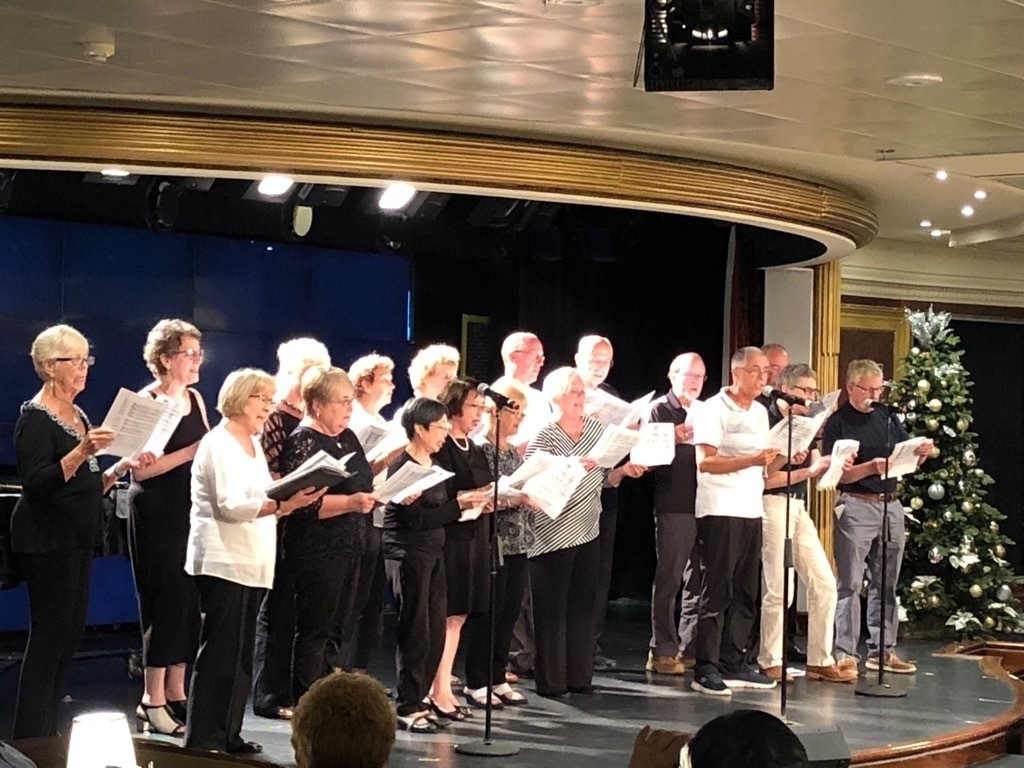

Cooking with Pearly
Cooking with Pearly
Stand under the clock tower facing the roundabout at 9:00 and my husband will find you. Those were our instructions from Pearly, our instructor for the day. So we did, Jane and I plus our two friends Rob and Joan. Pearly’s husband was a bit surprised to find Rob and Joan with us, but there was room in the class and it was no problem. Just a couple of more things to pick up at the market.
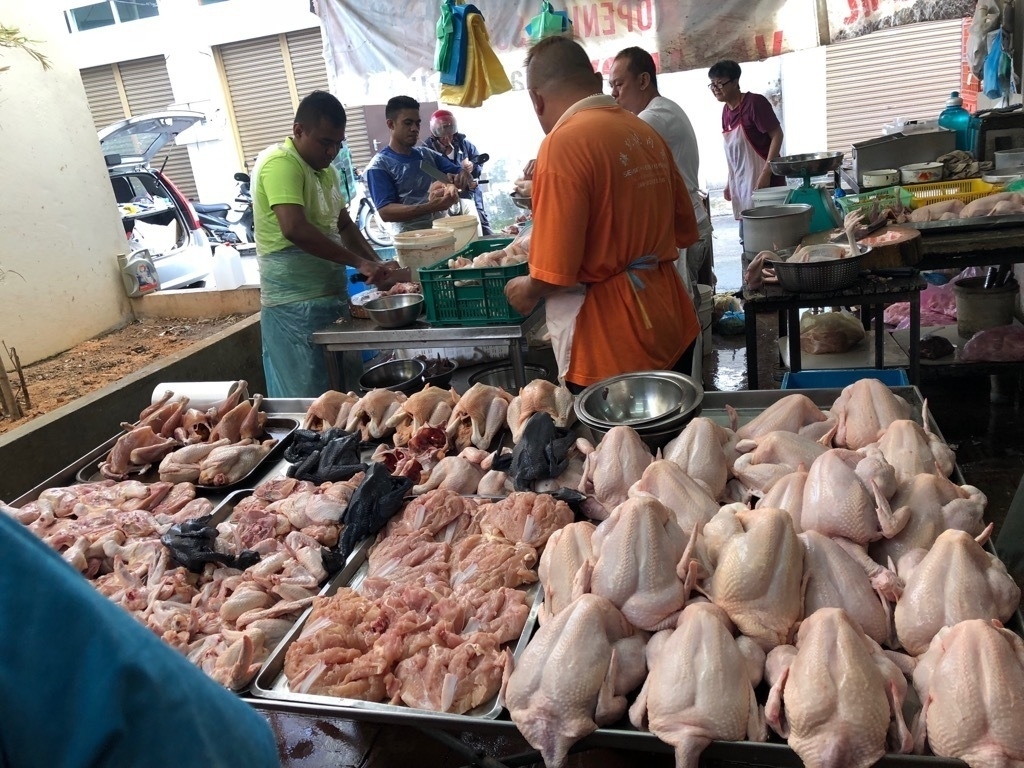
Chanda, Pearly’s husband drove us to the market where we waited for Pearly to arrive with the rest of the class. Then our lessons started. She did a great job of showing us around the market introducing us to all of the Malaysian produce. She was particularly focused on educating us about the various health benefits of all of the different kinds of root vegetables. By the time it was over I actually kind of wanted to eat a healthier diet with more greens and veggies. You read it here first folks! We also had the opportunity to try some great street food, including some peanut pancakes and some rice hoppers that were made with noodles, cane sugar, and coconut. Delicious!
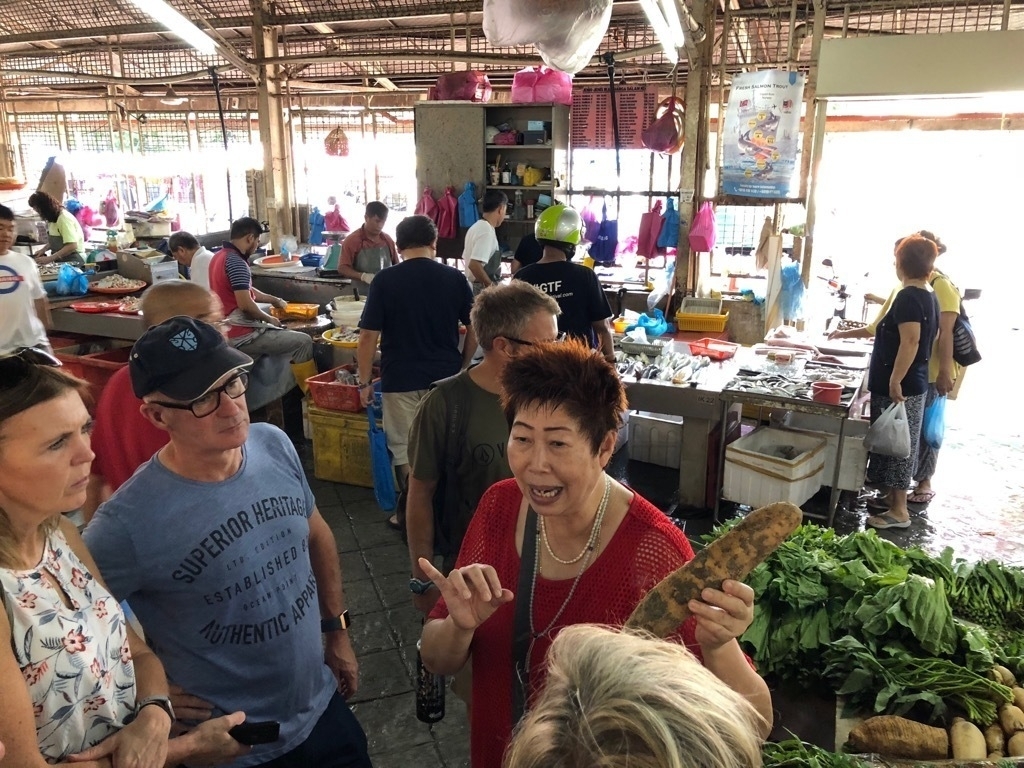

After the market tour we drove to Pearly and Chanda’s home where she gave us a tour of the garden and then brought us to our cooking stations. Since Jane and I were the first to sign up for the class we got to choose the dishes to make! We made three dishes:
- Curry Kapitan
- Sambal Goreng -- Prawns in Cashew nut sauce
- Ngor Hiang Lor Bak - 5 spice pork roll
None of these is the traditional Penang curry that we eat back home, but they are all traditional Nyonya dishes. Pearly is a fifth generation chinese living in Penang and they are the Nyonya. Over the years of cooking for the British they developed a style of cooking that was very flavorful but not as spicy as their Thai counterparts.

In each step of the work we washed everything thoroughly in a large bowl of fresh water at each of our stations. This was a little different than how I had cooked before, but the produce was all fresh and so whether it was to make sure we coaxed out any weavels hiding in the nuts or just to make sure we rinsed away any extra dirt or other nasty matter from the lemon grass or dried chilis or Galangal roots it seemed like a good idea.
When we first started it seemed like we might be in an episode of “worst cooks” as some of our classmates immediately knocked their ingredients on the ground and started cutting things up all wrong. But Pearly had pretty good humor about it and we spent most of our time laughing. She did go a little overboard at one point grabbing the spoon out of Jane’s hand in a misguided effort to “save her peppers” after her instructions about what to do were not entirely clear.
We didn’t finish cooking and eating until 2:00 in the afternoon, but the time went by very quickly.

Sunrise to Sunset in Bagan, Myanmar
Sunrise to Sunset in Bagan, Myanmar
One of the cool things about this Azamara journey is that the ship stays for three nights in Yangon (old Rangoon) which allows some of the more adventurous travelers the opportunity to do an overnight trip to the interior of Myanmar (formerly known as Burma). Our friends Ann and Jerry got us very excited about seeing the temples of Bagan so this was the perfect opportunity to do that.

Jane worked with Trufflepig travel agency to plan our days to get the most out of the adventure. Which we definitely did as we were off the ship early on our first morning in port and were were among the very last handful of passengers to board less than an hour before we sailed away from Myanmar! Our first day was a fairly nice tour of Yangon. The main attraction is the huge gold covered Schwedagon Pagoda. They were in the midst of a project they do every five years to replace the gold plating on the dome of the pagoda. We saw families dressed in their finest bringing a 10 by 10 inch plate of gold to place in a small cart that would go by wire up to the dome where it would be put in place. This must be the most expensive pagoda in the world, as the very tip of the pagoda is encrusted with diamonds, rubies and sapphire gems worth millions.
The expense of the pagoda stands in stark contrast to everything around it. It seems that people are giving away their life savings to decorate this place. Its a part of the culture that I would definitely like to understand more about. I should also point out that Myanmar is also fairly well endowed with gold mines, diamond mines as well as mines containing rubies and sapphires. But like many of our other stops there is also a huge amount of poverty.
The flight to Bagan was about an hour aboard a propjet plane, and we were met by our guide, Mr. Htay, and driver for our time in Bagan for the short five minute ride to the Aureum Palace Hotel. A beautiful 5 star hotel where the bathroom in our villa was bigger than our entire stateroom on the ship! The dining and pool areas of the hotel overlook several smaller pagoda (pagodas? pagodi?). Although it was still only around 7pm we ate dinner at the hotel. The menu was a very international menu including burmese, Thai, Italian, and American fare. Our server recommended anything from the Thai menu as the chef was from Thailand and very good. I had the Pad Bai Kra Prao Gai -- something I’m determined to cook at home. its a bit similar to Laarb but spicy instead of bright and fresh. Its ground chicken mixed with spices and spicy basil served over rice.
After dinner it was early to bed, partly because I was suffering from a nasty cold and partly because we knew we had a 4:40 alarm set to get up for our balloon ride the next morning! I slept well until 2AM and then spent the rest of the night tossing and turning waiting for that early alarm to go off, and anticipating the balloon ride! See the gallery at the end of this post for a bunch of photos.
We travelled to the launch site in a Carbus! The Carbus is a vehicle that was made in Canada and used by the Allies in World War II. At the end of the war there were 206,000 of these vehicles in Burma but it was too expensive to ship them all back home so they were just left here. Over the years the burmese have restored them, replaced and engines, and used them for various purposes. The windows were open air, or you could pull up some wooden shutters to block the early morning breeze which we did since it was the first time since leaving home that we were a bit chilly. (it was probably 69 degrees out)

We arrived at the launch site in darkness where they had coffee and tea waiting for us and then it was on to our safety briefing. As the sky began to turn gray in the east the safety briefing was over and it was time to inflate the balloons! What a fascinating process, to watch them start up fans and then run around inside the balloon making sure everything was in place. After the balloons were about three quarters inflated they started the burners and started shooting flames into the balloon, which very quickly became upright and ready for us to board! There were sixteen passengers in four compartments of the basket. The pilot, Fernando, was in the middle with his tanks of fuel and his ipads to show the wind speeds at various altitudes. it took a lot of hot air to get all seventeen of us into the air, but it was so gentle and amazing that you didn’t even realize you were leaving the ground. Once airborn we were all just mesmerized by everything! temples in every direction and the sun just peeking over the horizon.
We were probably in the air for a little over an hour and I alternated between madly taking pictures trying to capture the experience and just leaving my camera hanging so I could fully enjoy the experience! There were 23 balloons in the air that morning and part of the beauty of the experience was seeing all of the other balloons around us. It was all over too quickly when we landed (on our second attempt) in the middle of a field. Our pilot had to hold a delicate balance between letting the balloon deflate a bit versus keeping it upright enough so that the basket didn’t tip and drag until the ground crew caught up with us.
After we got out of the balloon we celebrated our journey with an early morning champagne toast. The first balloon flight was in the Champagne region of france so apparently this is a tradition followed after all balloon flights. Our pilot got into ballooning when he got fed up waiting for parts for an ultralight plane. Now he owns his own company in Spain, and spends five months of the year in Bagan doing balloon rides and five months in the south of france doing balloon rides. Quite an interesting life if you ask me!
After the balloon we returned in our Carbus to the hotel where we cleaned up, had breakfast and then met our guide for our eBike tour of the temples of Bagan. the eBike was a great way to explore the backroads around the temples. We explored a few that were off the beaten path and getting a bit overgrown, and then we saw a few of the popular ones that we had seen from the air. It was really interesting to have a good guide for this part of the trip as the walls of the temples are like history books. The different paintings and the stories they all tell always make me wish I had done more homework before visiting.


After a few hours of “templing” we drove our scooters to a monastery and had a huge burmese lunch. It is said that one of the kings in Bagan never had a meal with less than 300 dishes. We had 30. The traditional meal is to have a main curry and rice dish and then many many side dishes. We had two different beef curries and one chicken curry. That leaves 27 different side dishes. From tofu to pickled bean sprouts to mashed gooseberries to spicy toasted nuts. We managed to try a bit of everything between us. Many of them we didn’t like at all because they were just too bitter for our western taste buds. I’m not sure that even my friend (JMS) would have cleaned up all the food they served us.
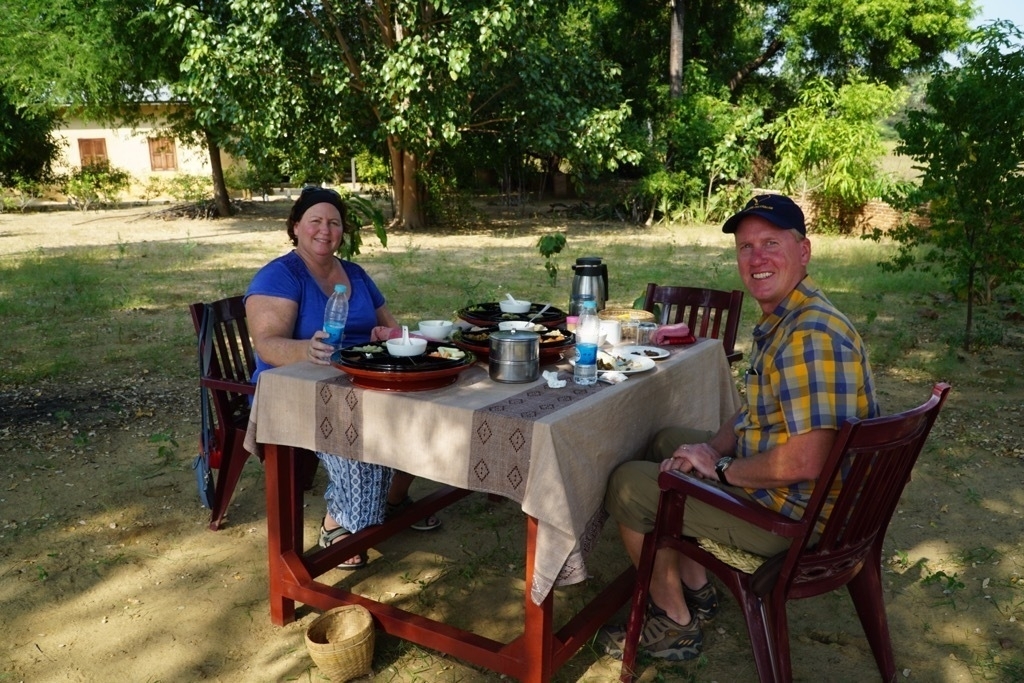
One of the best things about our guide was that he didn’t overdue the temples. After lunch he said we could continue if we wanted or we could go back to the room for some rest and refreshment before he picked us up at 4:00 for our carriage ride and sunset watching. We opted for resting and trying out the rum sour drinks from the hotel bar that our guide had recommended we sample. They were very refreshing all on their own.
The carriage ride was very peacful and the sunset was beautiful.
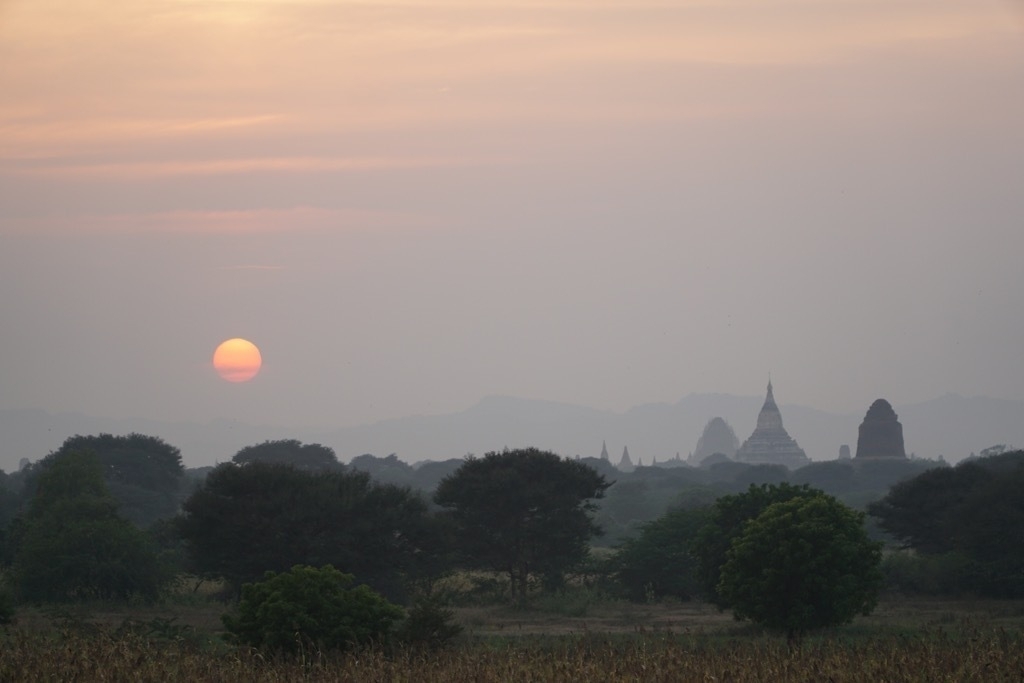
After sunset we were beat, so we had an early dinner by the pool and enjoyed the reflection of the nearby temples in pool. It was another early night to bed as we knew we were off to the airport first thing in the morning.
My one worry about the hole Bagan adventure had been that we were not leaving ourselves a very good safety margin for getting back to the ship at the end of it all. Our flight was schedule to arrive at 10:10 and the roads and traffic in Yangon are so bad that it takes at least an hour and a half to drive from the port to the airport. With our ship leaving at 1:00 I would have liked a bit more time. On top of that virtually everyone we met was flying back the night before for that very reason. Of course they all missed the sunset. So... when the time to board our plane passed and the ground crew told me that our flight was delayed by 30 minutes due to weather in Heho my stomach began to churn a bit. My internal safety deadline of 11:00 was getting uncomfortably close. Of course we knew that we had our passports and credit cards and more than a day to catch up with the ship in Phuket if we “missed the boat.” So there really wasn’t anything to worry about. But sometimes you still do even when you shouldn’t. Our plane landed at 10:50 and our guide was waiting for us. He joked that they had the privte jet all fueled up and ready to take us to Phuket, but we made it back to the ship before it sailed anyway.
Yala Safari
Yala Safari
Today we got caught up in a traffic jam in the middle of the Yala National Park in Sri Lanka! But it was for a good reason, a Leopard. After many hours of bumping around the jungle in a jeep and seeing lots of different animals we still had not seen a leopard. We really didn’t expect to as it was hot and the middle of the day. Most of the sane leopards were hidden away napping on tree branches. We knew that something was up as soon as our driver hit the gas pedal. We had learned over the course of the day that when he sped up and started driving like a madman it was because some other driver had seen something cool and it had come down their phone tree. How they tell each other their position out there is something only they know, I think, as there are thousands of paths and zero road signs.
After a few minutes of flying along we ended up at the back of a very long line of jeeps going nowhere. initially the word was that it was a crocodile, which didn’t seem all that likely as a croc would not attract this much attention. Eventually we learned that it was a Leopard! What a bonus that we were actually going to see one. After nearly a half hour of inching forward one car at a time we were pointed in the right direction by several of the guides who were standing by the side of the road trying to keep everyone moving. It was quite far in the distance but I did get a great view of it with the binoculars. Unfortunately it was too far away for any kind of recognizability unless you really zoom in like below.

Not everyone in the Jeep was so lucky and we learned a good lesson about traveling with tired and crabby people. The poor driver was just doing his job and following instructions. But after six hours in a jeep in 90 degree weather, it was a bit much for one couple who had been bickering with each other all day!
The following is a gallery of some of my favorite photos taken during the day. Enjoy! And if you ever get to Sri Lanka I recommend you plan a day like this.
Driving a Tuk Tuk in Colombo
Driving a Tuk Tuk in Colombo
This morning we had a morning at sea and we arrived in Colombo Sri Lanka noon. Jane had arranged a tuk tuk tour for us and several other people from the cruise critic message boards. We made our way off the ship and negotiated a taxi to take us to the hotel where we were to meet our drivers and tuk tuks. In case you’ve never experienced a tuk tuk it is a three wheeled vehicle with a motorcyle engine. The driver sits in the front and 2 or maybe 3 passengers sit in the back. These vehicles are all over in the cities of Asia and can drive in ways that cars cannot!

The first thing we noticed is what a different vibe there is in Colombo versus the cities in India. The driving is more orderly, the city seemed quite well maintained from the lack of garbage in the streets to the upkeep of the buildings. We visited a Buddhist temple, saw “the white house”, visited a Hindu temple, the national cricket grounds, and some of their national monuments.
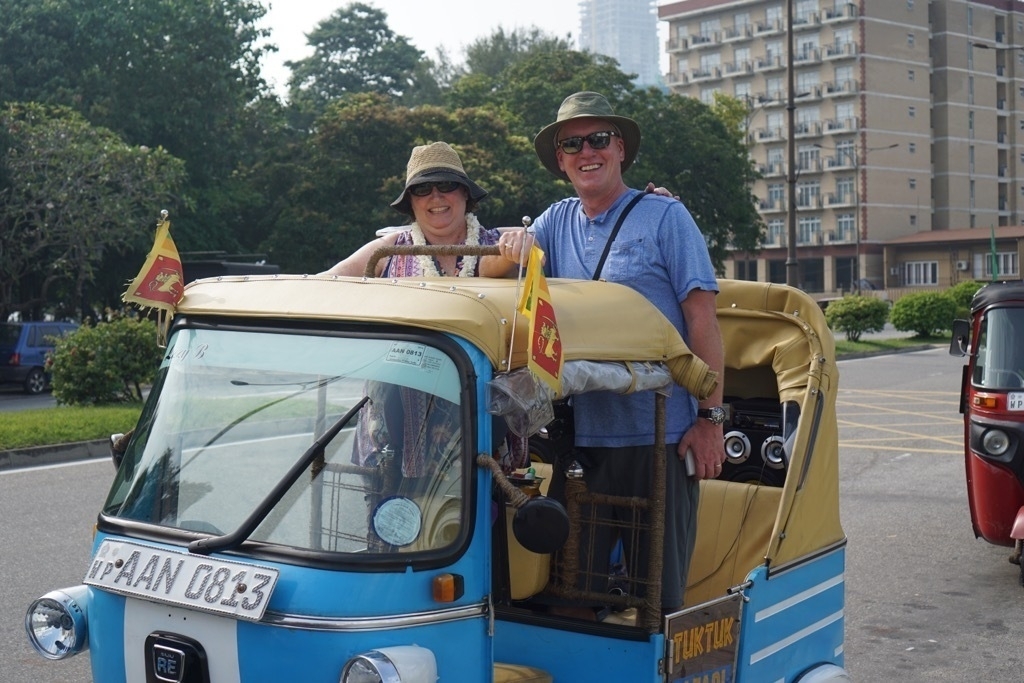
For me the highlight of the day was when we were on a pretty out of the way street and our driver pulled over and asked if I wanted to drive. Now I’m not even a motorcycle driver, but that didn’t deter me from giving it a shot. Unlike a motorcycle the clutch is on the left and along with the shifting mechanism, the throttle is on the right hand along with the break. I made it into first gear without any trouble and then paniced when I heard someone coming up from behind me. I slowed down and forgot to engage the clutch. Wah wah wah... But then we started it up again and I was good for at least 1 kilometer.
The funniest thing was that as we were motoring down the road with me driving we were passed by a policeman! It was pretty clear to all concerned that I didn’t have a license, but he just smiled and continued on his way. Jane was in the back making a video and thought the whole thing was quite funny.
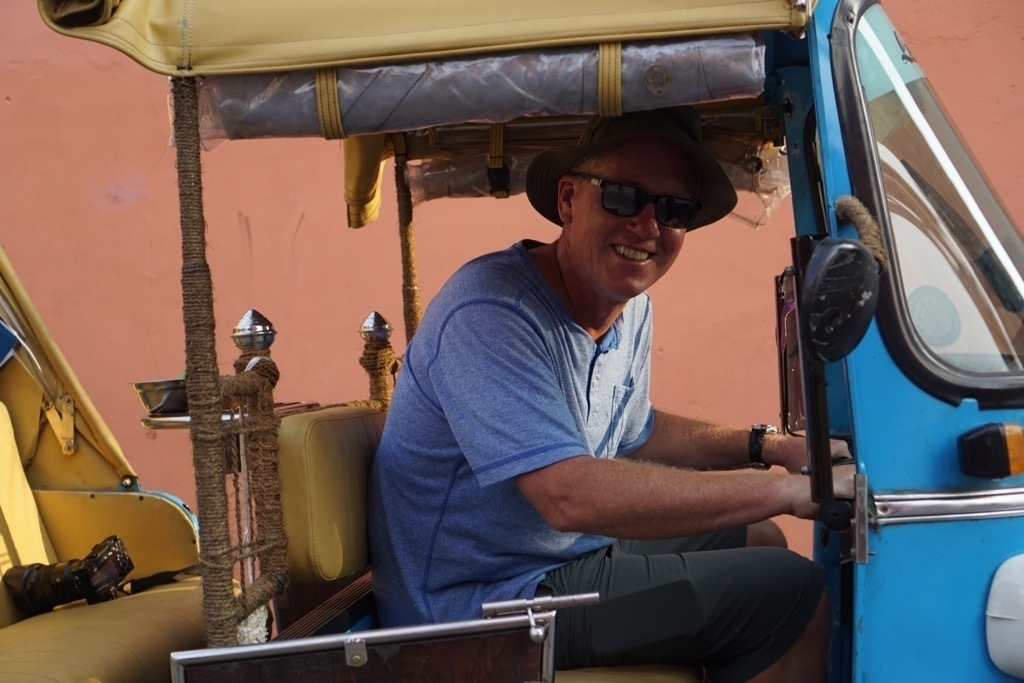
While we were at the national cricket grounds, I noticed that they had something called “Hoppers” on the menu. So I asked our guide about it. He explained that they were like crispy pancakes that you stuffed with different fillings and rolled up to eat. A few minutes later he was on the phone and arranging for us to have hoppers on our lunch stop! They were delicious. We had some spicy filling called pol sambola to use with one plain hopper and one egg hopper. Both were really good. Then we had a delicous chicken Kottu a mixture of roti and vegetables and chicken, served with a dark garlic curry. We were running a bit behind schedule but we were all so glad that we got to experience this great food instead of rushing back to the ship to make the dinner buffet! For desert we had some delicious buffalo milk curd with honey drizzled on top. Time to find a Sri-Lankan cookbook to see if I can recreate any of this at home.

Kochin: Houseboats and Driving
Kochin: Houseboats and Driving

I think that no blogging about India would be complete without some comment on the driving! It is a great example of both the chaos and cooperation present in the culture of India. It is utter chaos in that although there are line lines painted on the roads, very few drivers seem to care. Where there is only one lane you might find two or even three vehicles side by side depending on the size of the vehicles. Passing? No problem you can pull part way out of the lane to pass, the vehicle in front of you will probably move over a bit to the left and the oncoming traffic will likely move a bit to the right so you can get around! I don’t know what the statistics on traffic accidents or fatalities are in India, but amazingly we didn’t see any during our visit to either Mumbai or Kochin. I tried to make a video out the front of the bus as we were driving down the road and staring into an oncoming truck. But it didn’t turn out so you’ll just have to trust me on this one!
Our day in Kochin was mostly spent on a small bus studying the driving habits of the natives, but we did make two very interesting stops. The first stop was to do a two hour ride on a large houseboat that took us through the canals and waterways of Kochin. We got to see the countryside and the rice paddys. It was really good to get out of the city!



Our second interesting stop was at a small bridge where we could see the famous chinese fishing nets in action. These nets have been in use for centuries and it was fascinating to see them catching and hauling in the fish.

First World Problems
First World Problems
“First world problems eh?” We all use that phrase to acknowledge that when we are complaining about our iPhone being a little too slow, or our dinner selections not quite vast enough, we really do get that its not that important in the grand scheme of things. Today, we experienced life in the slum of Mumbai known as Dharavi, and it put into perspective the distance between our first world problems and real life. I don’t think I’ll use that phrase anymore as it feels like it doesn’t come close to recognizing the challenges faced by those living outside the first world.

Jane arranged our tour of Mumbai through a tour group called reality tours. They were excellent and I would highly recommend you use them if you ever visit Mumbai. Not only are the guides excellent but 80% of the proceeds from your tour dollars go straight into their community. Their community happens to be in one corner of the Dharavi slum. I was absolutely floored to learn that our tour guide for the day lived in the slum! I thought that slums were only for the very most poor and destitute, surely not for someone who was educated, well spoken and hard working! In fact we learned that many professionals such as teachers and policemen live in the slums of Mumbai. This reality runs straight against our American ideals, but we were not in America.
I’m pretty sure that we breathed som pretty toxic fumes on the first part of our tour today. The slum is divided into two parts, the commercial and the residential part. In the commercial part it seemed that recycling was a huge part of the economy, both lastic and aluminum. The plastic is broken down and then thrown into something that we Minnesotans would call a wood chipper, which breaks the plastic into smaller pieces. These pieces are then melted down and extruded into long strings and finally cut into tiny little lengths which makes little plastic pellets. These are then sold to manufacturers to be turned into who knows what. The dust and smell from the plastic can not be good for you. The same basic process is used for aluminum only that requires a lot higher temperatures. We saw a bunch of aluminum bricks that were so hot that people were cooking their lunch on them! In all of this we saw no hard hats, no safety goggles, and no shoes. We did see a lot of people working hard to earn money for their family.
In the residential area it was much different. The “streets” were so narrow that my shoulders stretched from one side to the other. The houses are quite small and for the most part families live together in a 10x20 foot room. Our guide was 30 and still lives with his parents and siblings because he cannot afford his own place. I learned that the average teacher’s salary is the equivalent of $200 per month, so it is no wonder that housing is hard to afford. Later in the day our guide took us past the most expensive house in the world a 2+ billion dollar home built overlooking the sea owned by an indian billionaire.
He explained that the government tried to clean up the slums and built hi-rise apartments next door for people to move into, but they were so expensive that nobody could afford them and most ended up moving back. Living in the slums is not free, people there pay taxes and rent and bills for water and electricity. Water only runs for a few hours a day, although electricity is pretty constant. Each home is metered for electrical use! Although the wires are run so haphazardly I can’t imagine how it is very accurate. We were not allowed to take pictures as our guide explained we are in people’s homes and want to respect their privacy. Everywhere we went, we were greeted by the children. They were all smiles and wanted to say hello to us, give us a high five or shake hands.

Another stop on our journey was the laundry. In a way this is similar to the slums in that people both live and work in the laundry. This is where the washing is done for hospitals and hotels and clothing manufacturers. We were able to take pictures inside here. Each of these large bins is one small business, doing the washing for someone.
Its all so strange and different, like a step back in time in some ways. Imagine that your hospital bedding was sterilized by throwing the sheets into a 50 gallon drum of water heated from below by an open flame!? Ironing? Of course they have ironing, have you ever seen an iron that is heated by coal? We saw some of them in use today.
So, although this part of the day was really sobering. We saw some fun and beautiful sites along the way too. The Victoria train station was very grand, and our stop at the cricket field was very entertaining. There must have been at least 100 different cricket games going on simultaneously. We watched as balls were hit across two, three, or even more other games. It seemed like total chaos to me, but it was clear that everyone was having a great time.
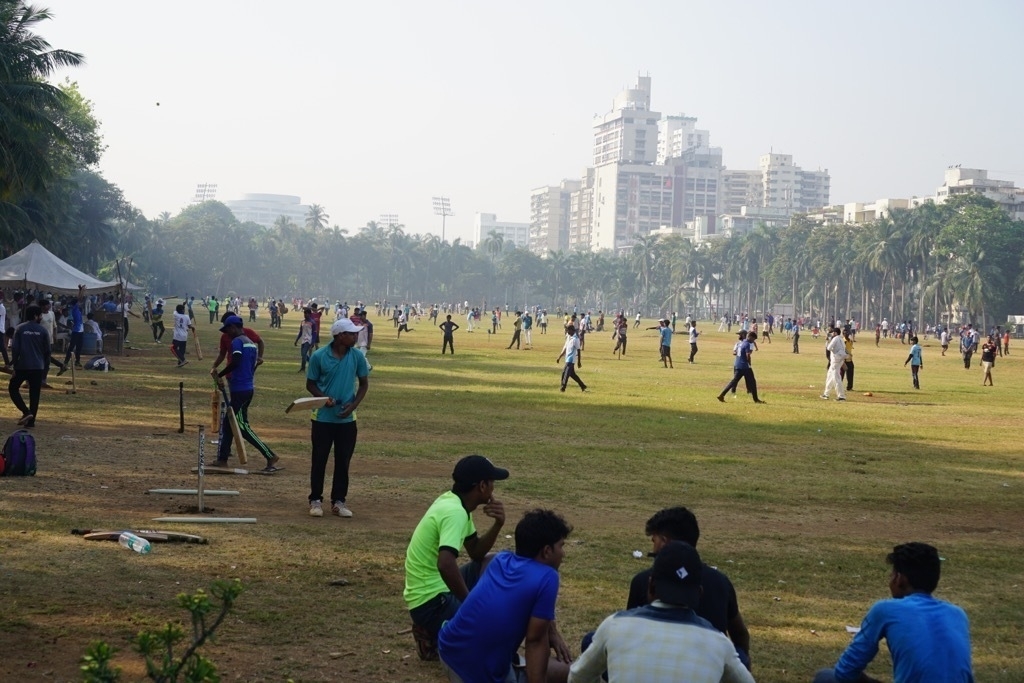
Our tour also featured a stop for some street food! We went to food stand at the beach owned by Bihm Singh, where we tried a number of different things. Pani Puri, Sev Puri and Dahi Ragda Puri. The Pani Pur and Dahi Ragda were both served in crisp little balls, where the cook punched a hole in the top and then filled the ball with delicious spicy ingredients. The Sev was more like a nacho in that it was a flat crispy bit of dough with the ingredients piled high. The way you eat these is to pop it all in your mouth at once. Jane got a fabulous photo of me demonstrating how to do this!


As far as I could tell the whole place was run on some kind of honor system. I never saw an order being written down, and yet people were eating all kinds of things chatting away and ordering and eating and chatting some more. like much of what we saw it seemed very cooperative and trusting amongst all of the participants. Such a different feel than you get in so many places back home.
I think the followup email from our guide sums up the day pretty well and since I’ve been struggling to put the day into words I’ll just quote him.
You have picked your way through Dharavi’s narrow, winding lanes, and witnessed first hand the communal, enterprising spirit that allows so many people to survive and thrive despite the many issues that they face. We hope you’ve left having had some of your perceptions about life here challenged.
To which I can only say, “mission accomplished.”
